Collection Guide: Gio Ponti
– Maristella Casciato and Rosie Ellison-Balaam
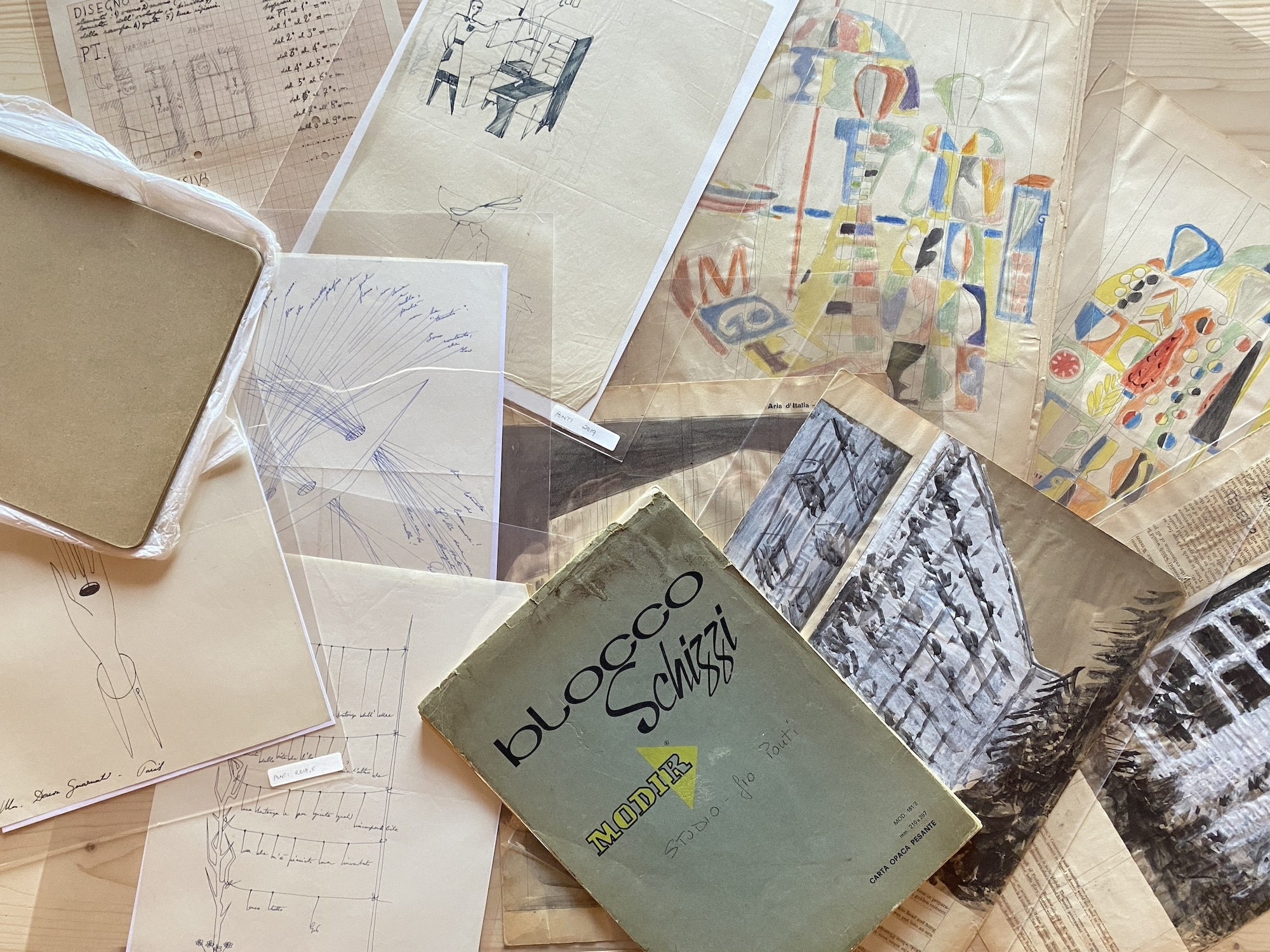
Gio Ponti (1891-1979) was born in Milan, and while he had ambitions to become an artist, he enrolled in architecture at the Politecnico di Milano in 1913. He completed his studies in 1921 after serving in the war, and in the same year, he opened his firm. Ponti is often celebrated as a singular architectural figure, but his career is marbled with a myriad of figures. He sits within a constellation of many actors: artists, artisans, architects, designers, editors, writers, and illustrators. Ponti’s early biography reveals the foundation of his private and professional networks. In 1921, he married Giuila Vimercati Borletti, a member of influential Milanese families; this is a connection that provides access to a socially and economically powerful circle, including early clients like the Fratelli Borletti. In 1923, he met Richard Ginori, another figure who would expand his creative potential, offering him the position of artistic director (1923-30) of his decorative arts business. Here, he meets critic Ugo Ojetti, who later helps with the formation of Domus in 1928. It is also through Ginori that he meets Tony Bouilhet, director of the Christofle firm, for whom he designs both a house and cutlery. As his career progressed, these figures grew and grew, collectively enriching his practice–the wealth of these relationships is documented in his extensive and highly personalised correspondence. Similar to his array of contacts, no discipline was above another, and it is important to view his work as an entire oeuvre. The writing, painting, ceramics, and architecture (to name but a few) spill into each other; viewing his work in this way offers a more nuanced understanding of his varied and deep body of work.
The works in the Drawing Matter collection, encompassing works from the 1930s to the 1960s, register the diverse actors and scope of Ponti’s practice. The designs range from everyday objects and individual dwellings to larger urban schemes, alongside handwritten letters and a publication mock-up. The majority of his work is held at the Archivio Gio Ponti in Milan, but the Centro Studi e Archivio della Comunicazione (CSAC) in Parma hold the bulk of his office’s material. Reflecting Ponti’s prolific correspondence, letters from him appear dotted across the globe.
ON GIO PONTI AND HIS APPROACH TO DRAWING, READ HERE 6 TEXTS, PUBLISHED ON DRAWING MATTER SINCE 2017.
TO ACCESS THE DRAWING MATTER COLLECTION OF GIO PONTI, CLICK HERE.
*
UNDATED WORKS
SKETCHBOOK
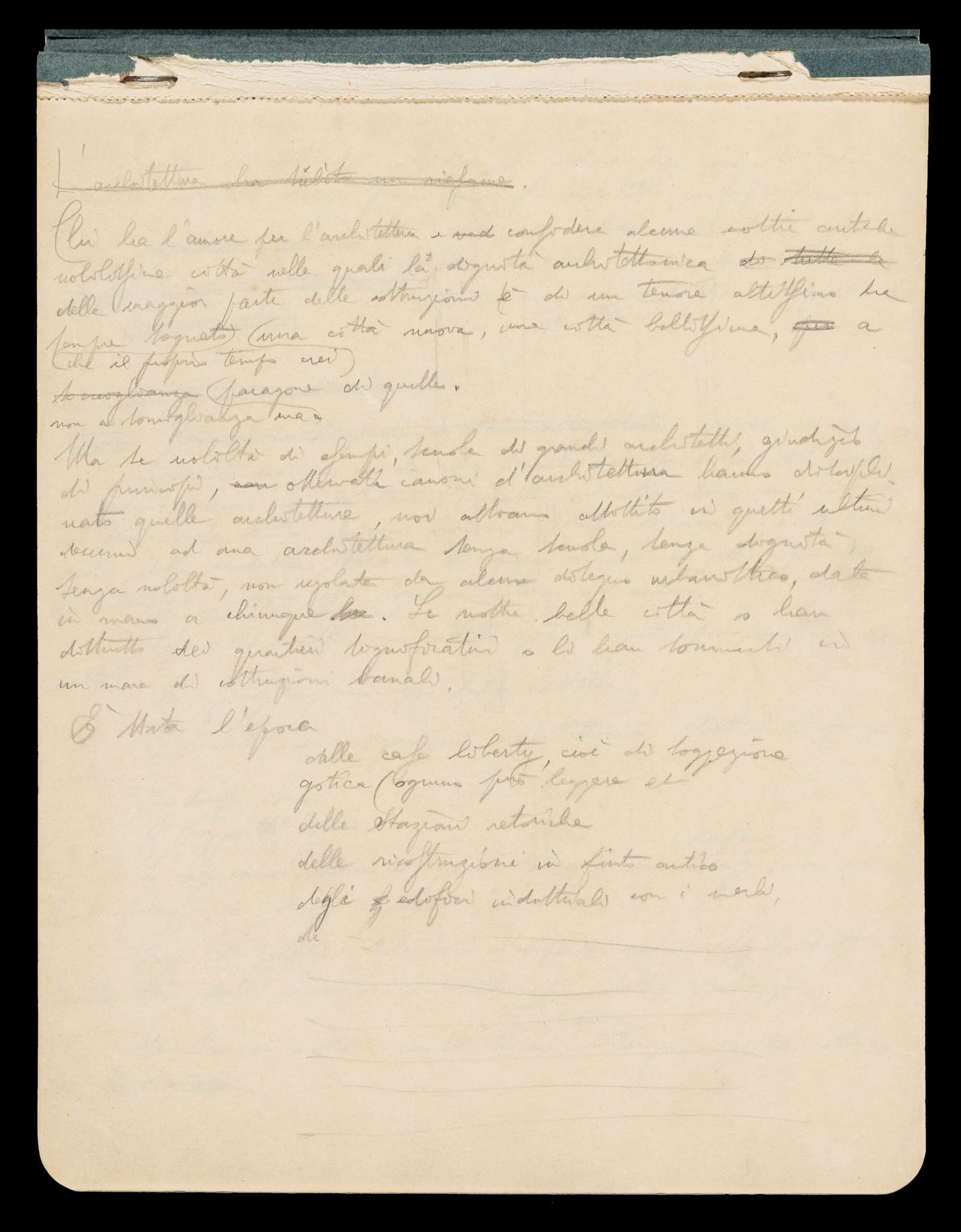
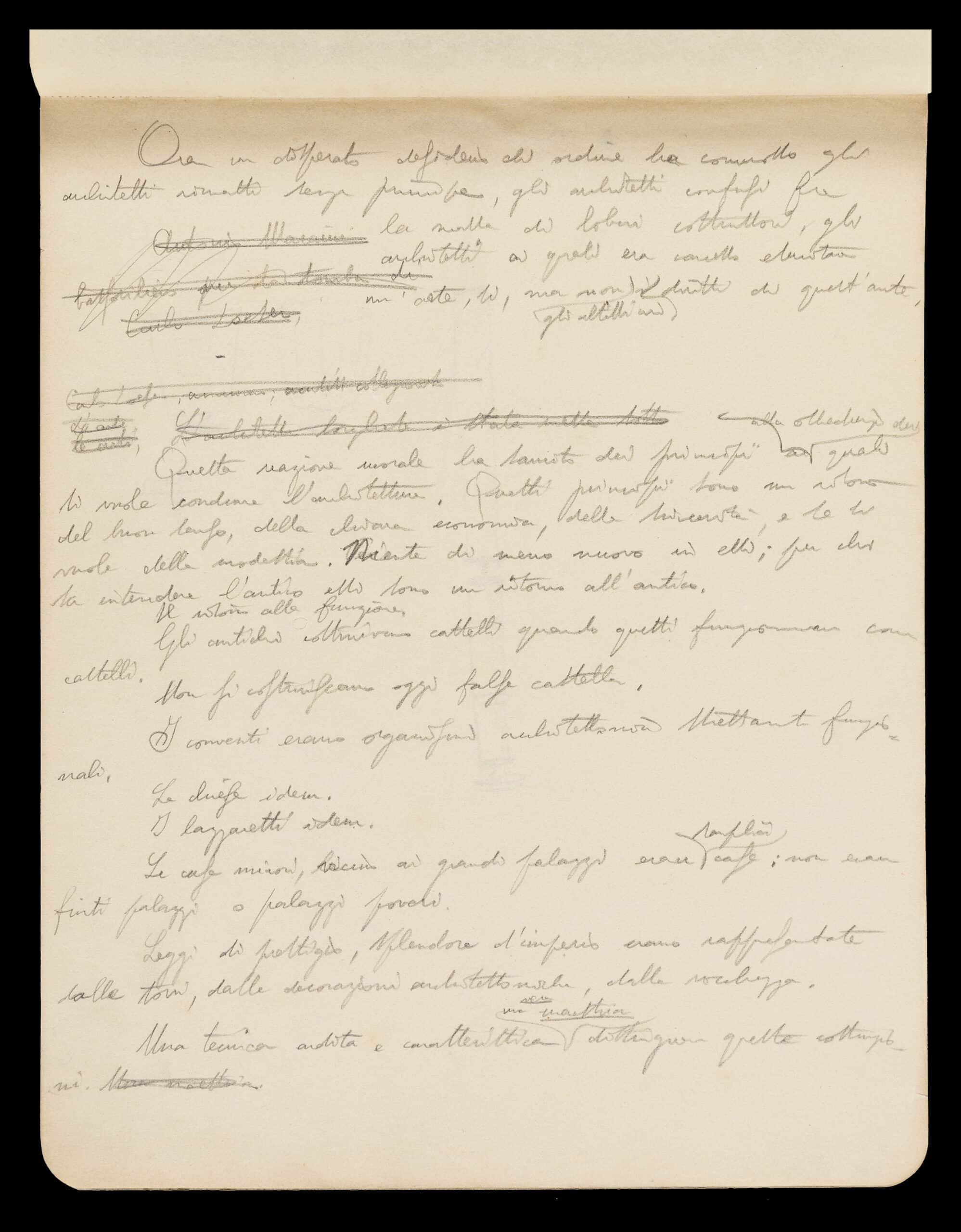
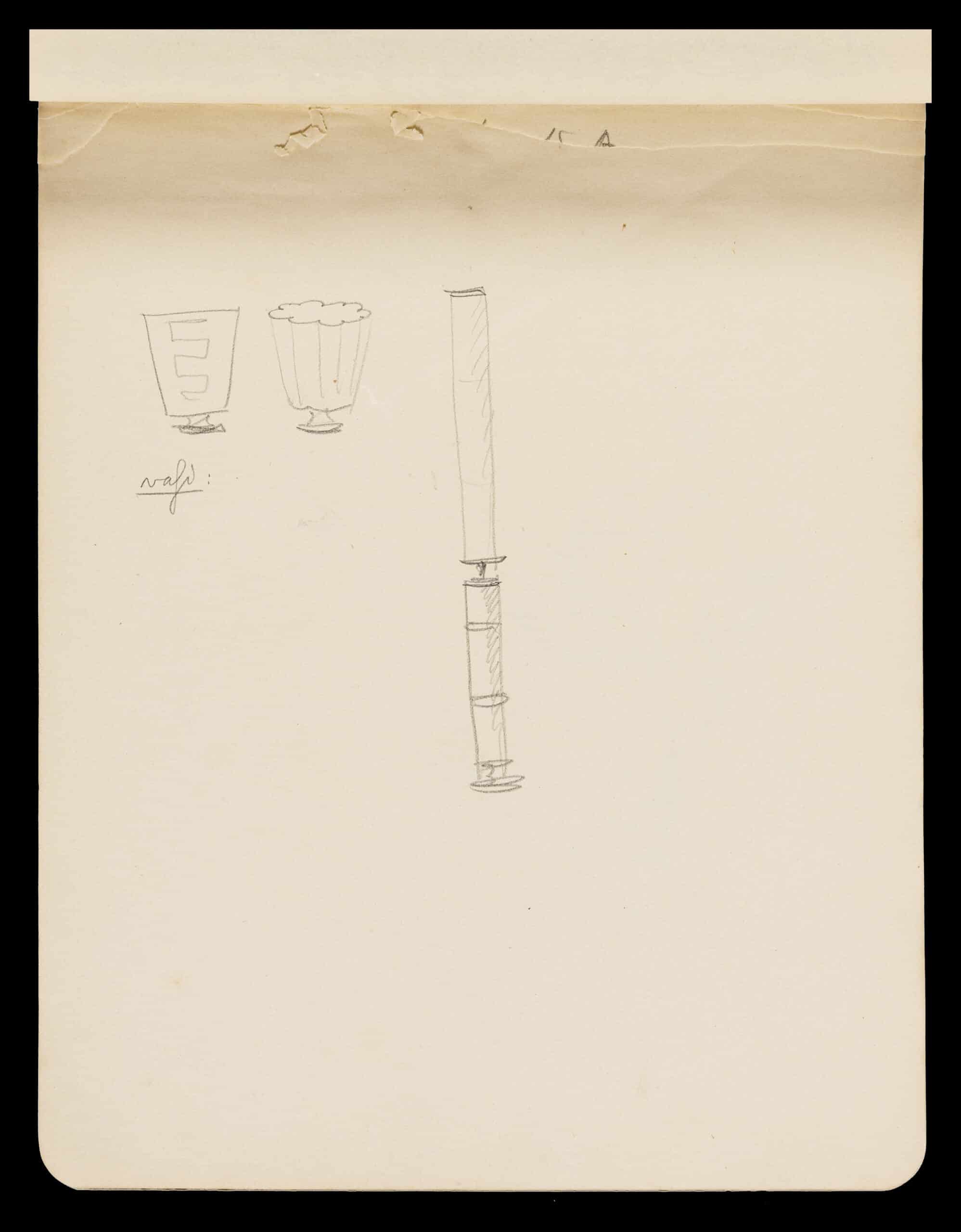
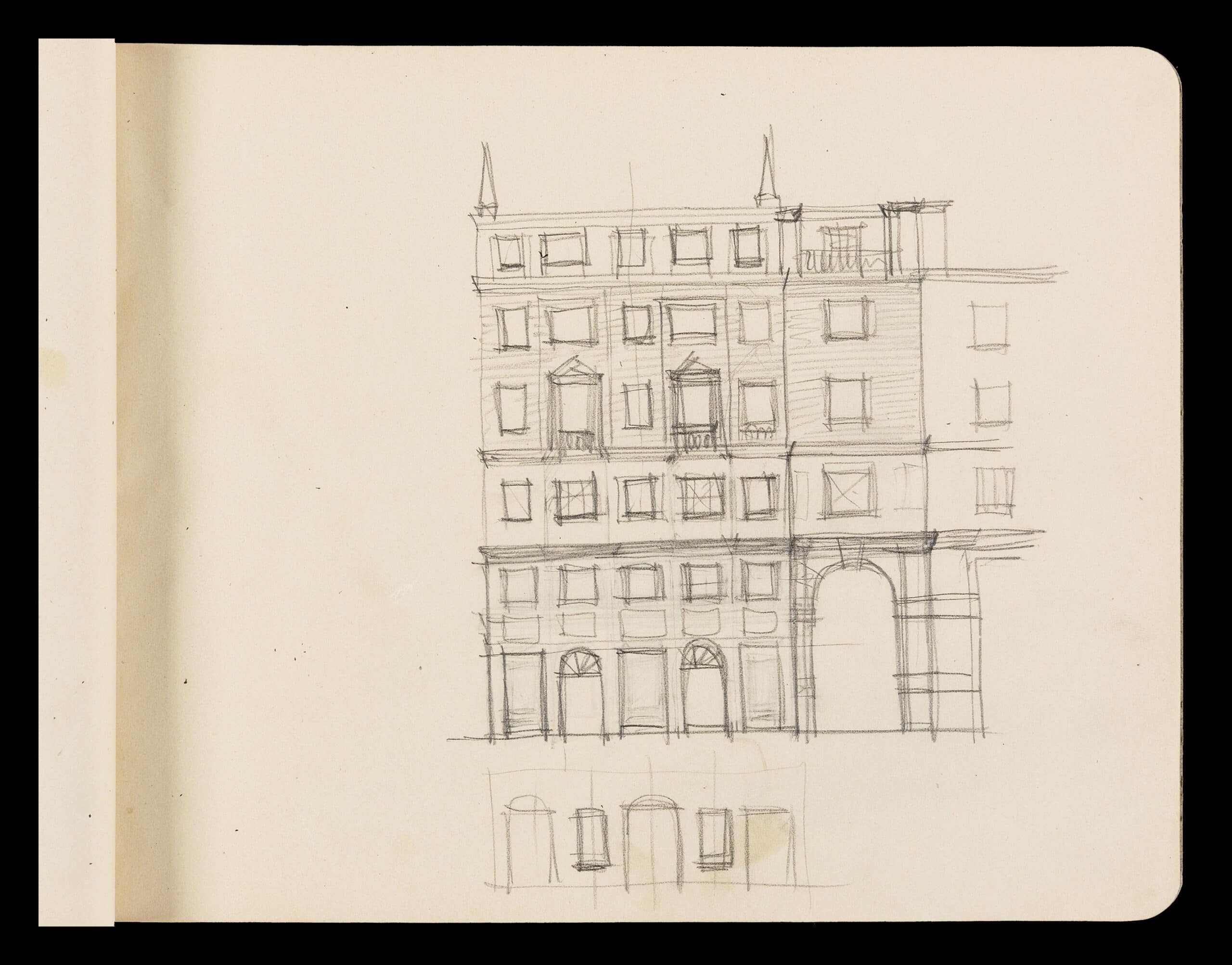
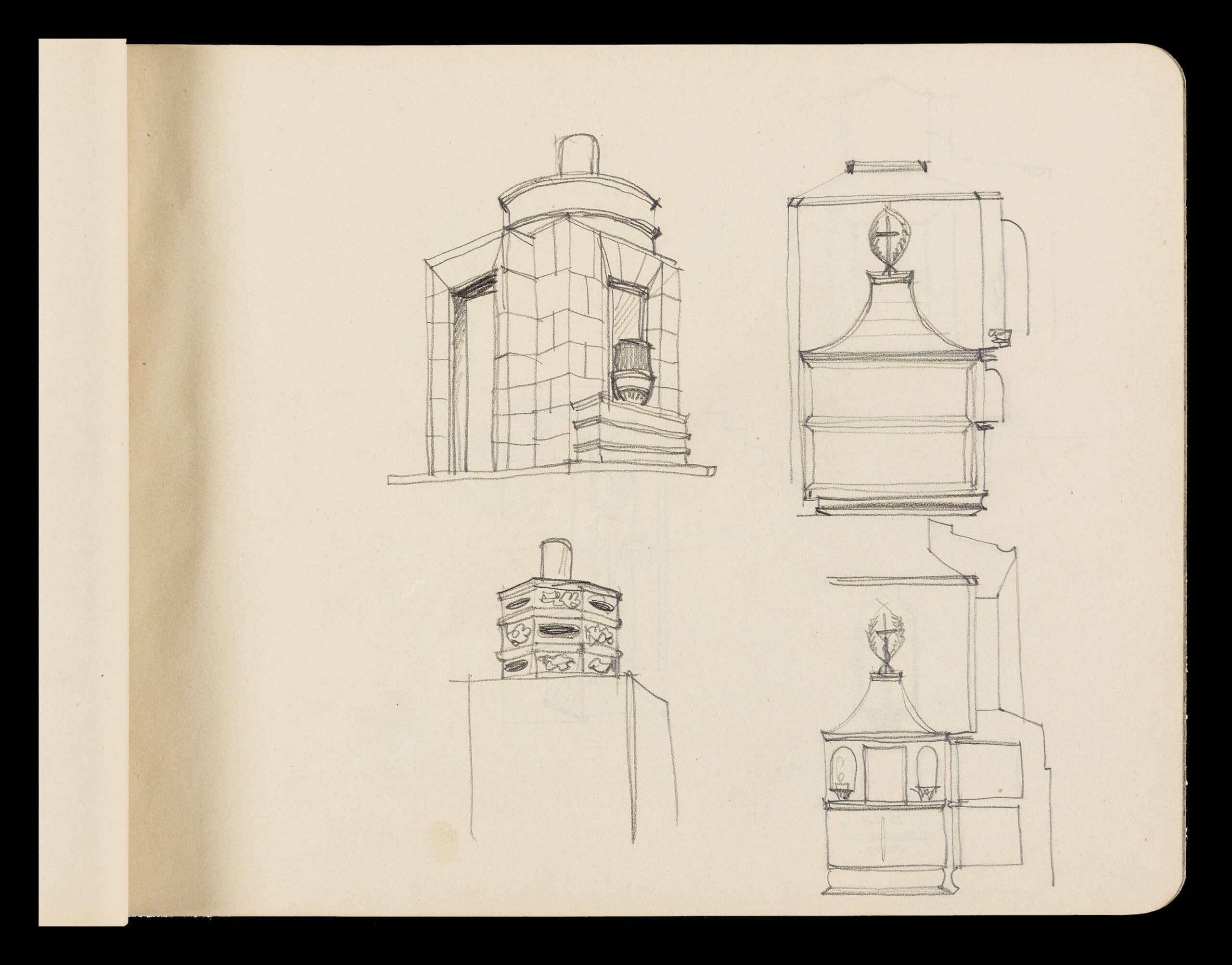
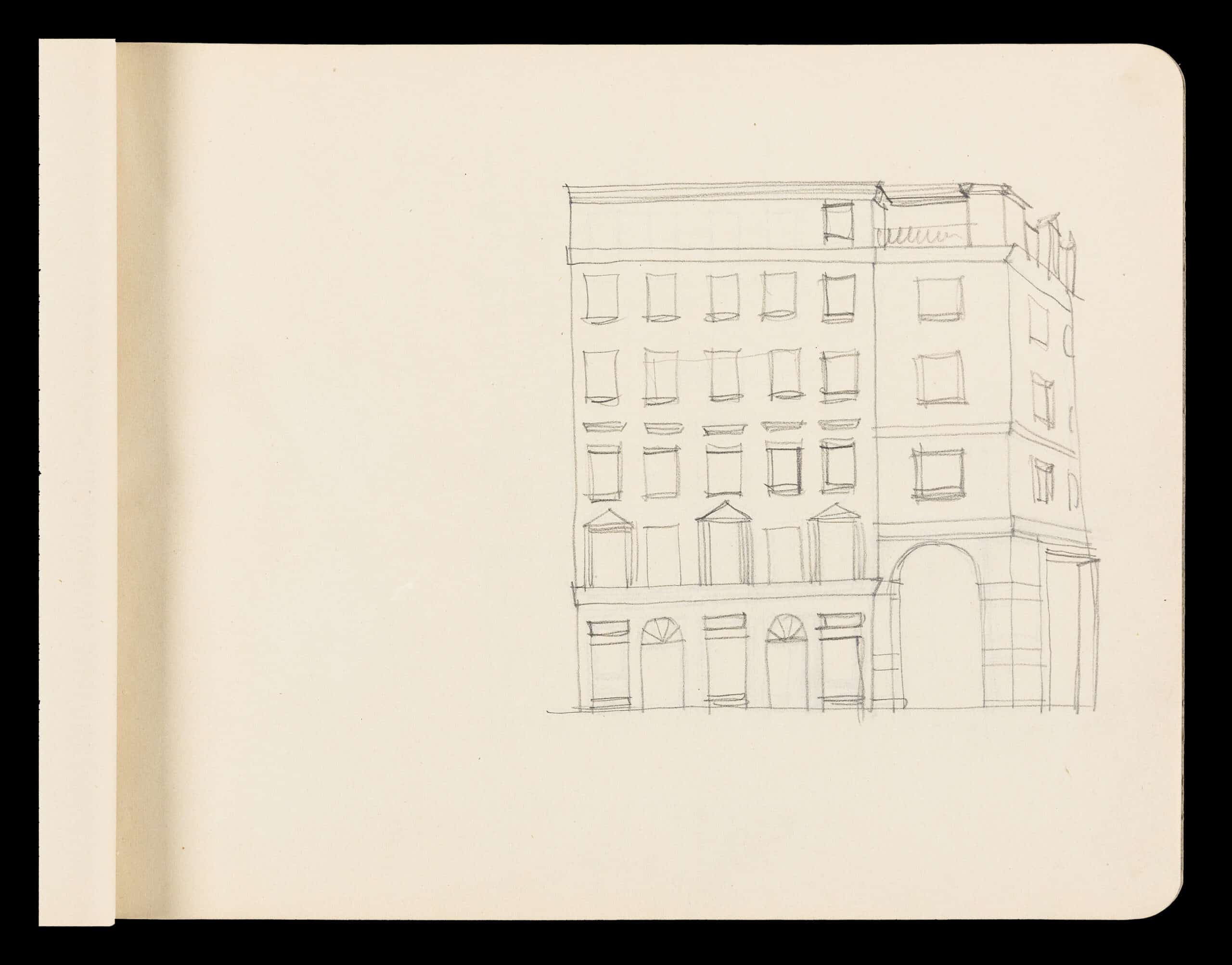
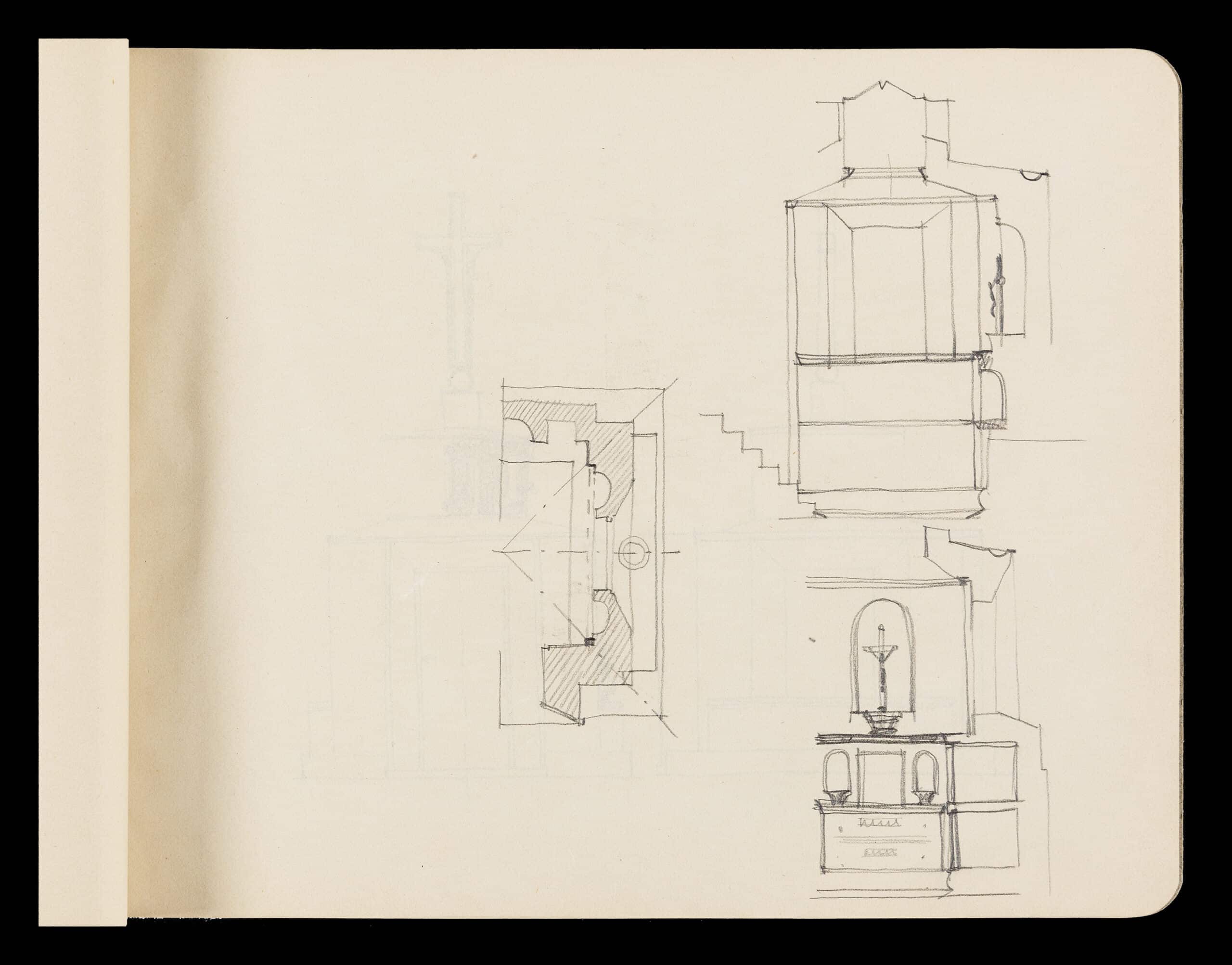
Carnet Croquis sketchbook with a simple card front and back and green fabric binding, pages inside held together with two staples; they have a perforated line, and it is visible that many pages have been torn out. The sketchbook opens with two pages of handwritten text, Ponti is writing and editing, crossing out, and rewriting passages. The text is titled ‘L’architettura ha subito una infamia’ (The architecture has suffered an indignity). It starts with the following lines, ‘Chi ha l’amore per l’architettura e vede considera alcune nostre antiche nobilissime città nelle quali la dignità architettonica delle maggior parte delle costruzioni è di un tenore altissimo, che ha sempre sognato (che il proprio tempo crei una città nuova, una città bellissima, non a somiglianza ma a paragone di quella).’ (Those who have a love for architecture and consider some of our ancient noble cities in which the architectural dignity of most buildings is of the highest tenor, who have always dreamed [that their own time would create a new city, a beautiful city, not in the likeness but in comparison with that]). It seems to present a strong architectural argument about what the discipline is and where it is going, with a concern for the emergence of finti palazzi (fake buildings).
The sketchbook continues with a page of three drawings for vases, similar in form to those Ponti created for Doccia Porcelain, inspired by Etruscan ceramics. Following are two pages sketching out a large building complex: a sequence of rectilinear forms, where Ponti toys with the idea of rounding their ends. This is followed by five pages of facade studies, where Ponti is working out an extension of a city block. The central facade’s arrangements of windows change in each sketch, with additions emerging around it. The project is unknown but was likely conceived for a competition, its urban form reminiscent of the Palazzo Marzotto in Piazza San Babila, Milan (1939). The following seven pages of sketches are for a tomb, more ornamental than Ponti’s design for the Cappella Borletti al Cimitero Monumentale (1929), more likely related to his later 1940 design for the Sissa funerary chapel at the Cimitero Monumentale, Milan. Yet it follows a similar form, with a confined footprint and a tessellated interior of steps and recessed spaces. The sketchbook captures his iterative process, moving from elevations to plans, sections, and perspective drawings to ornament details.
SKETCHBOOK
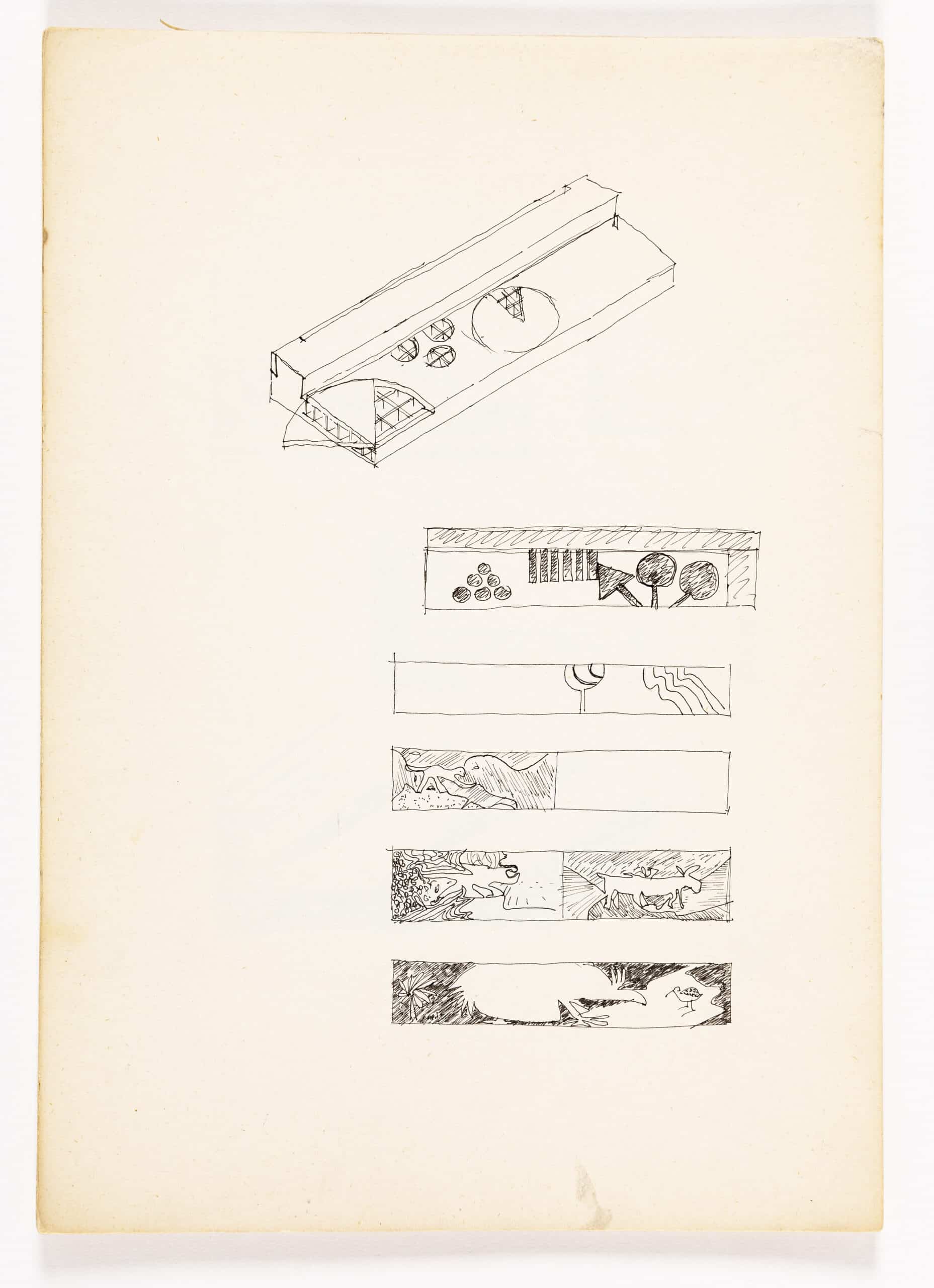
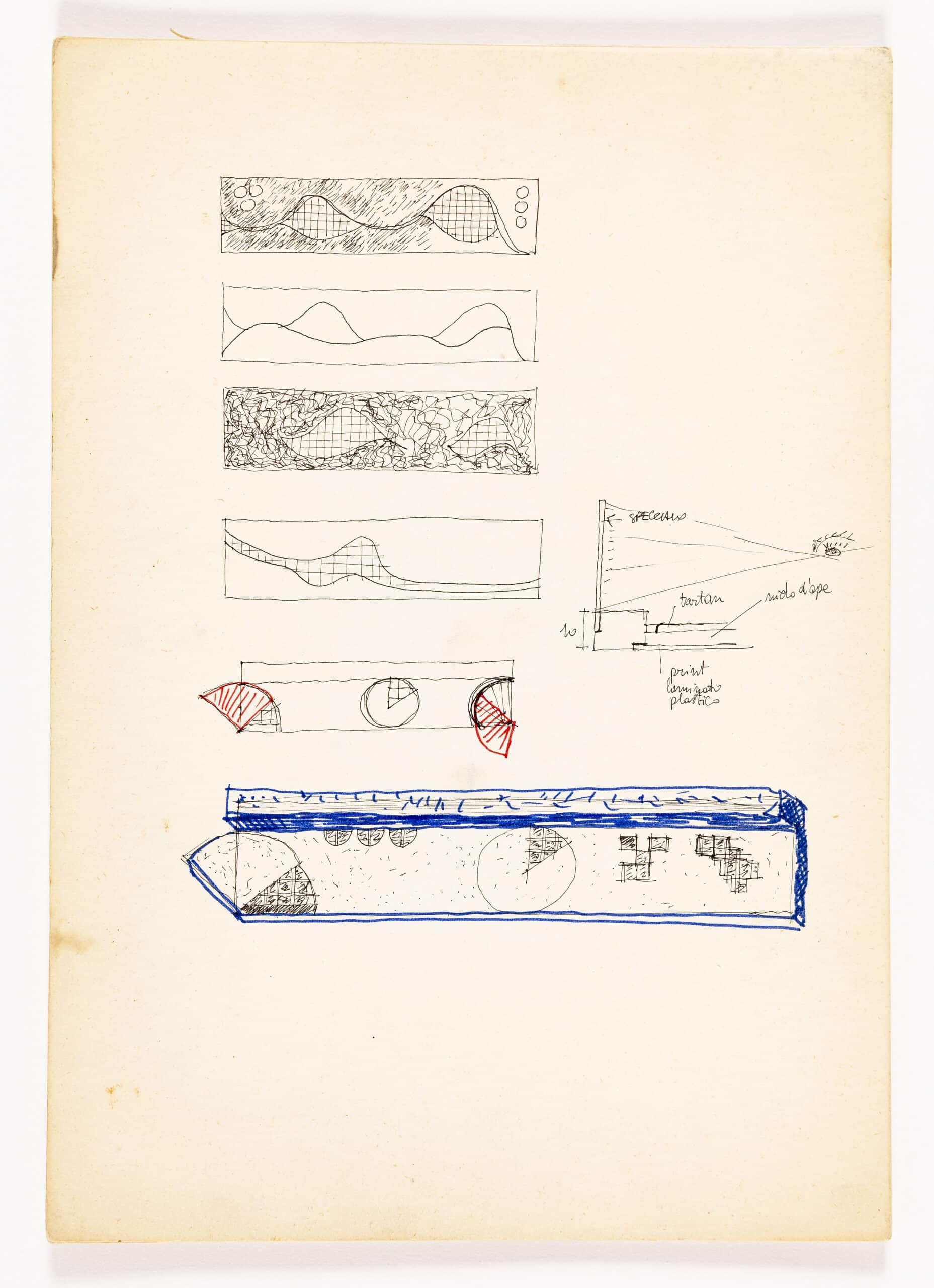
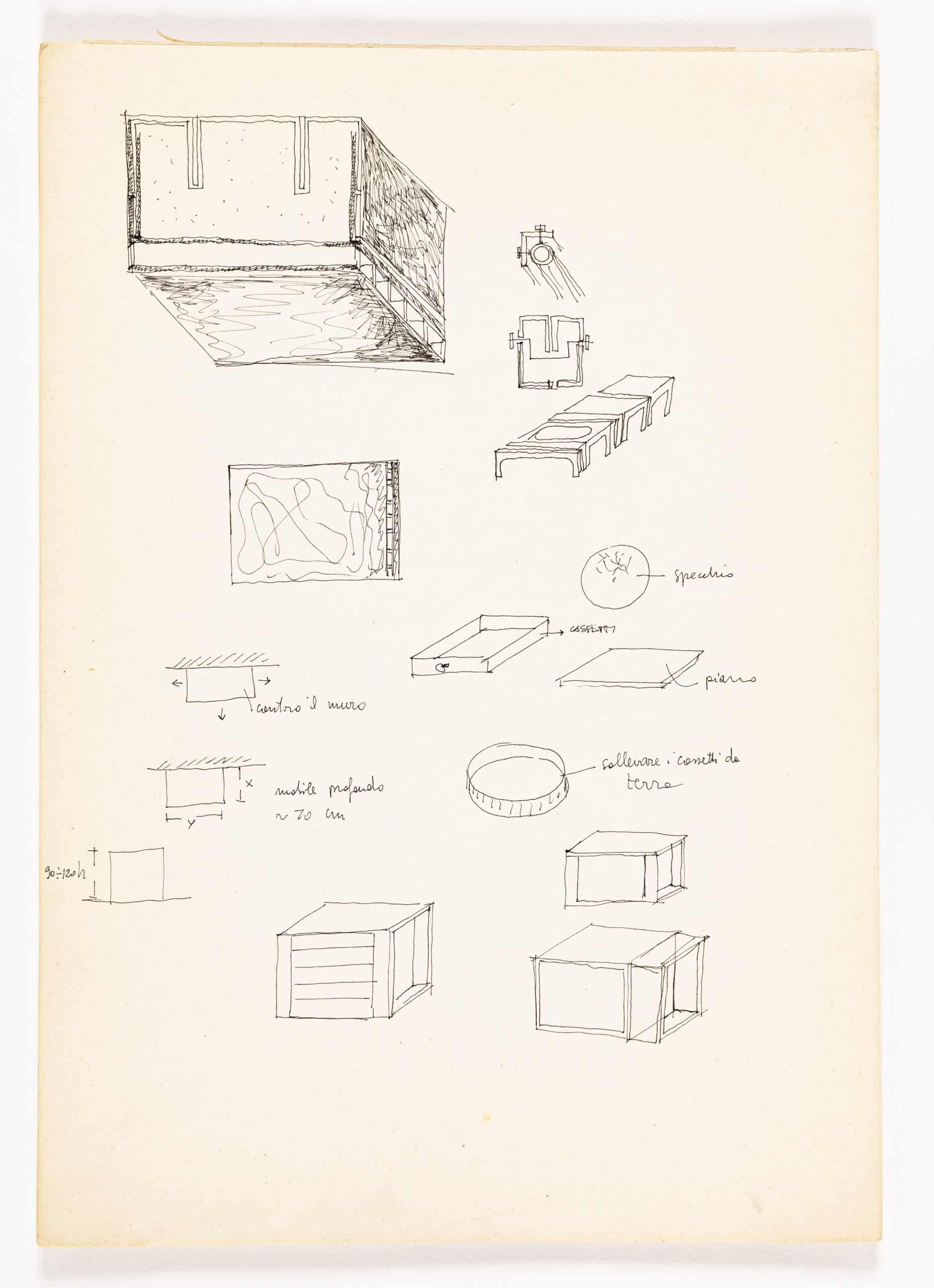
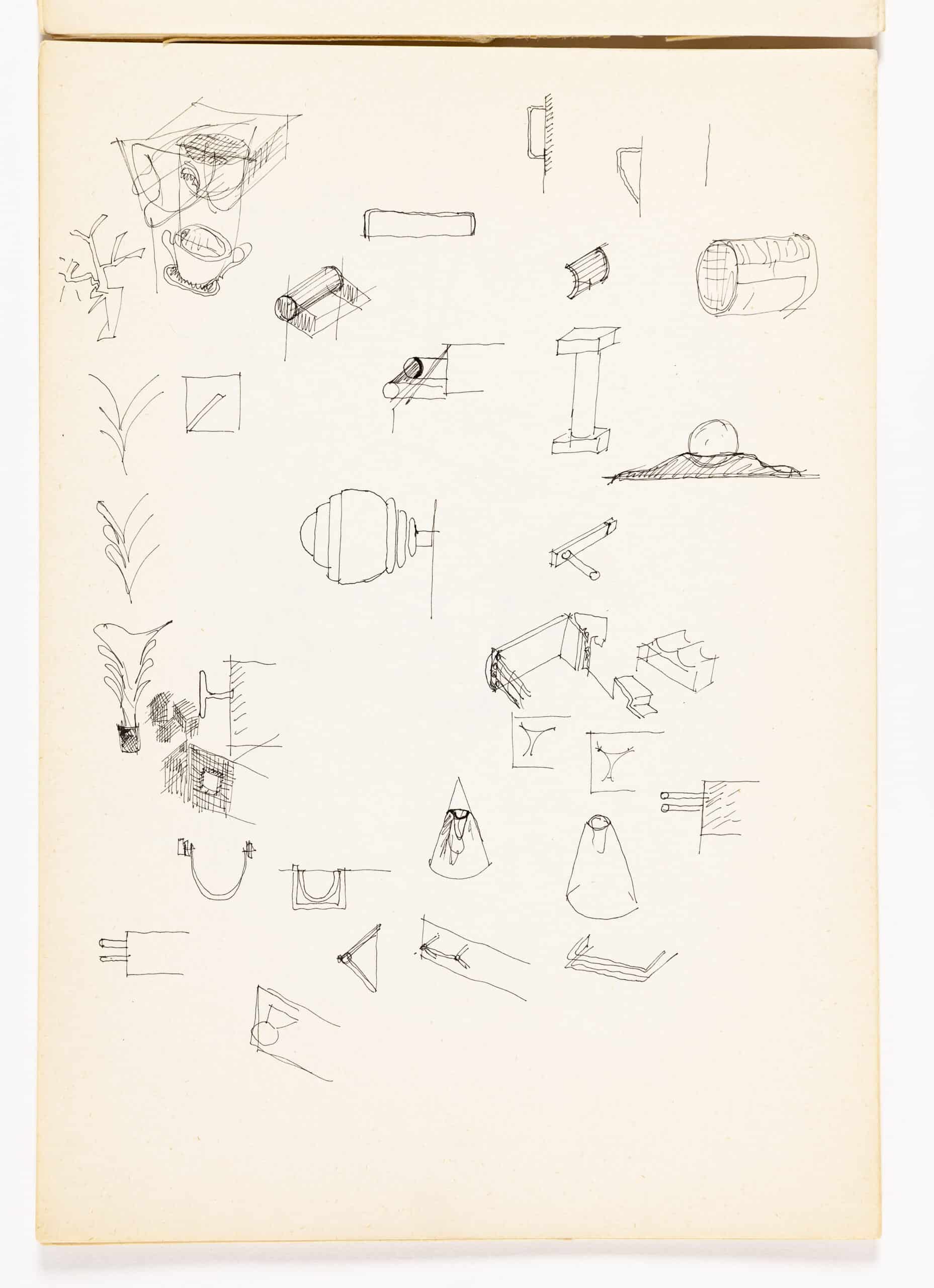
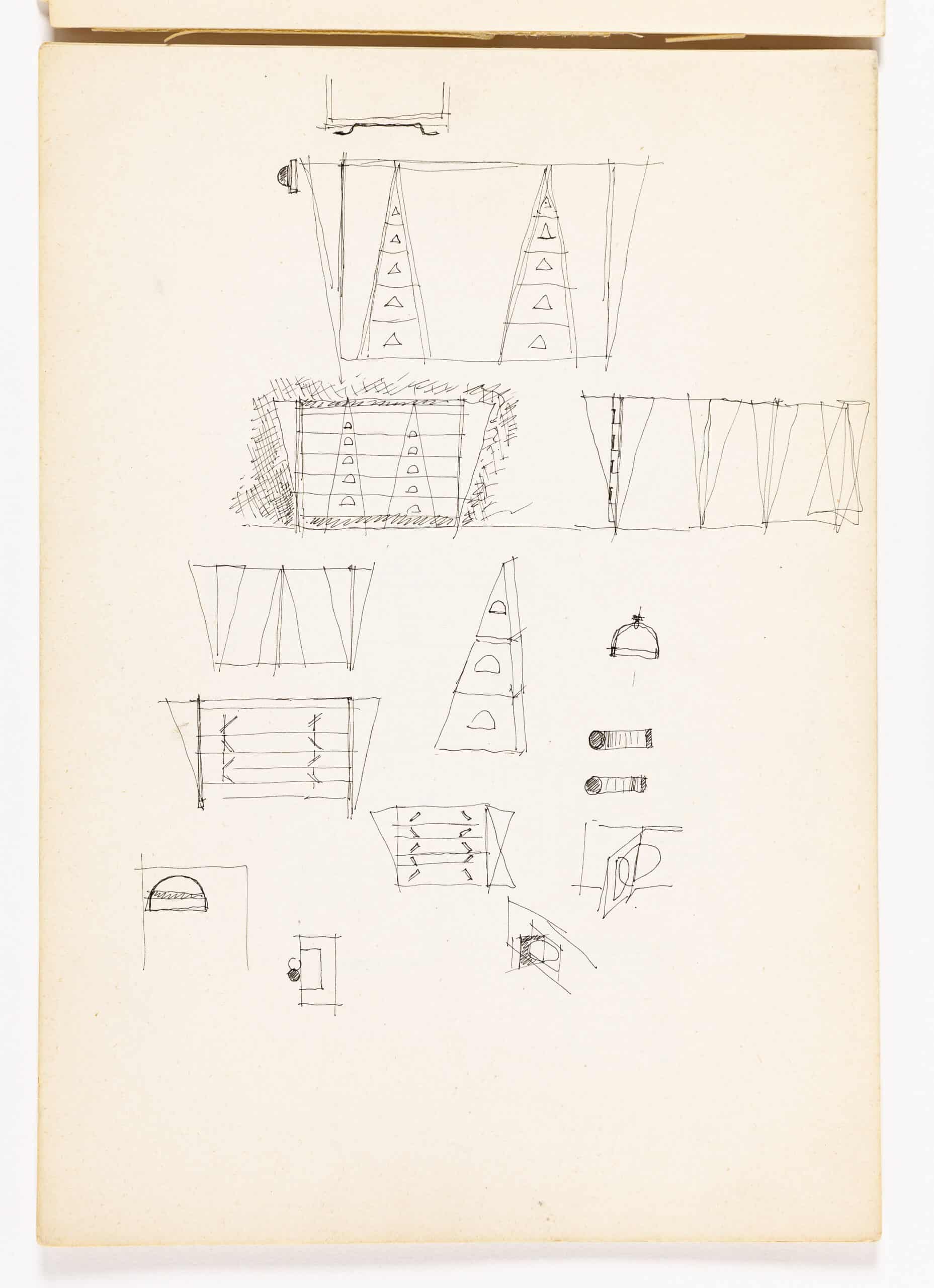
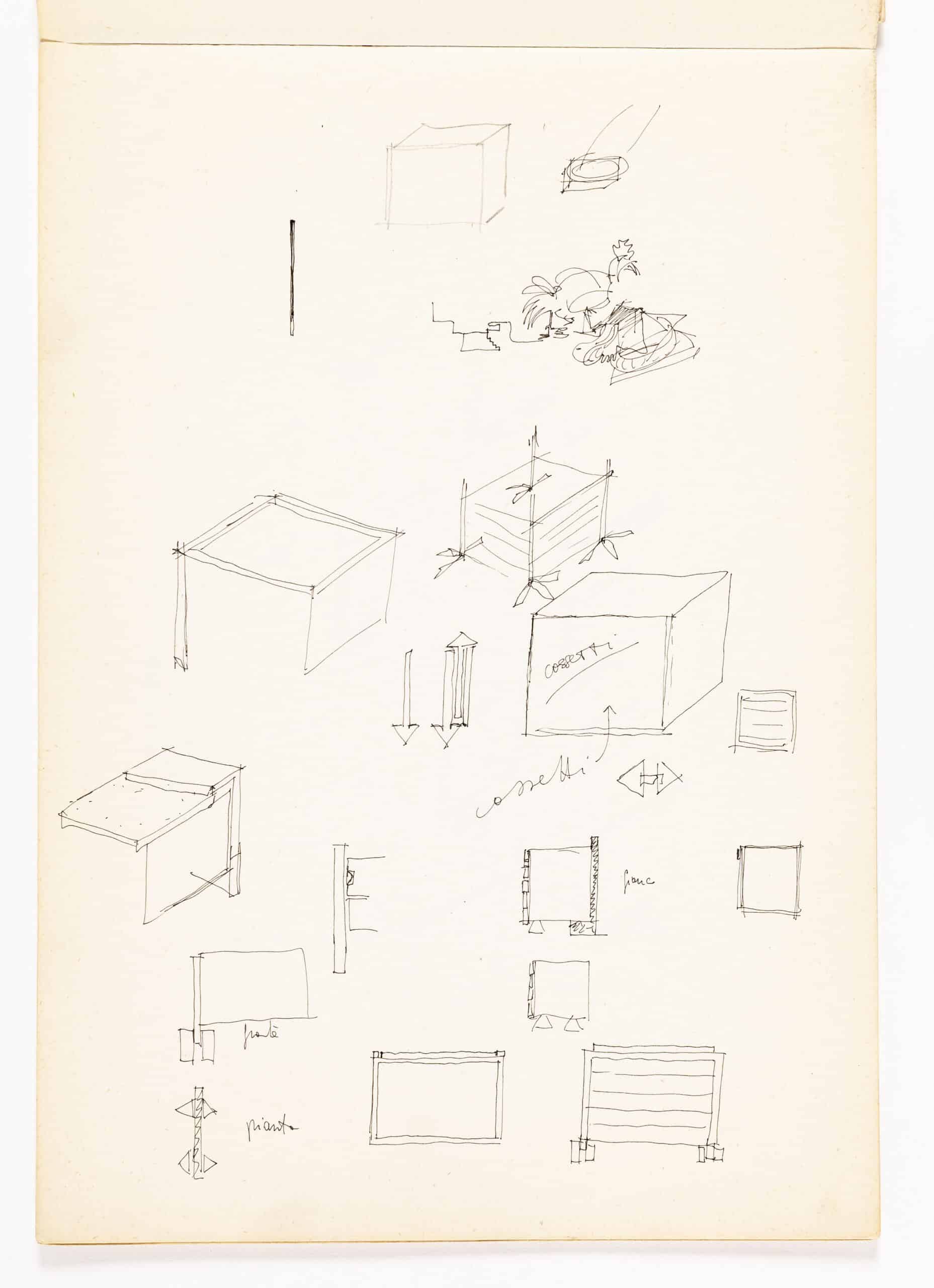
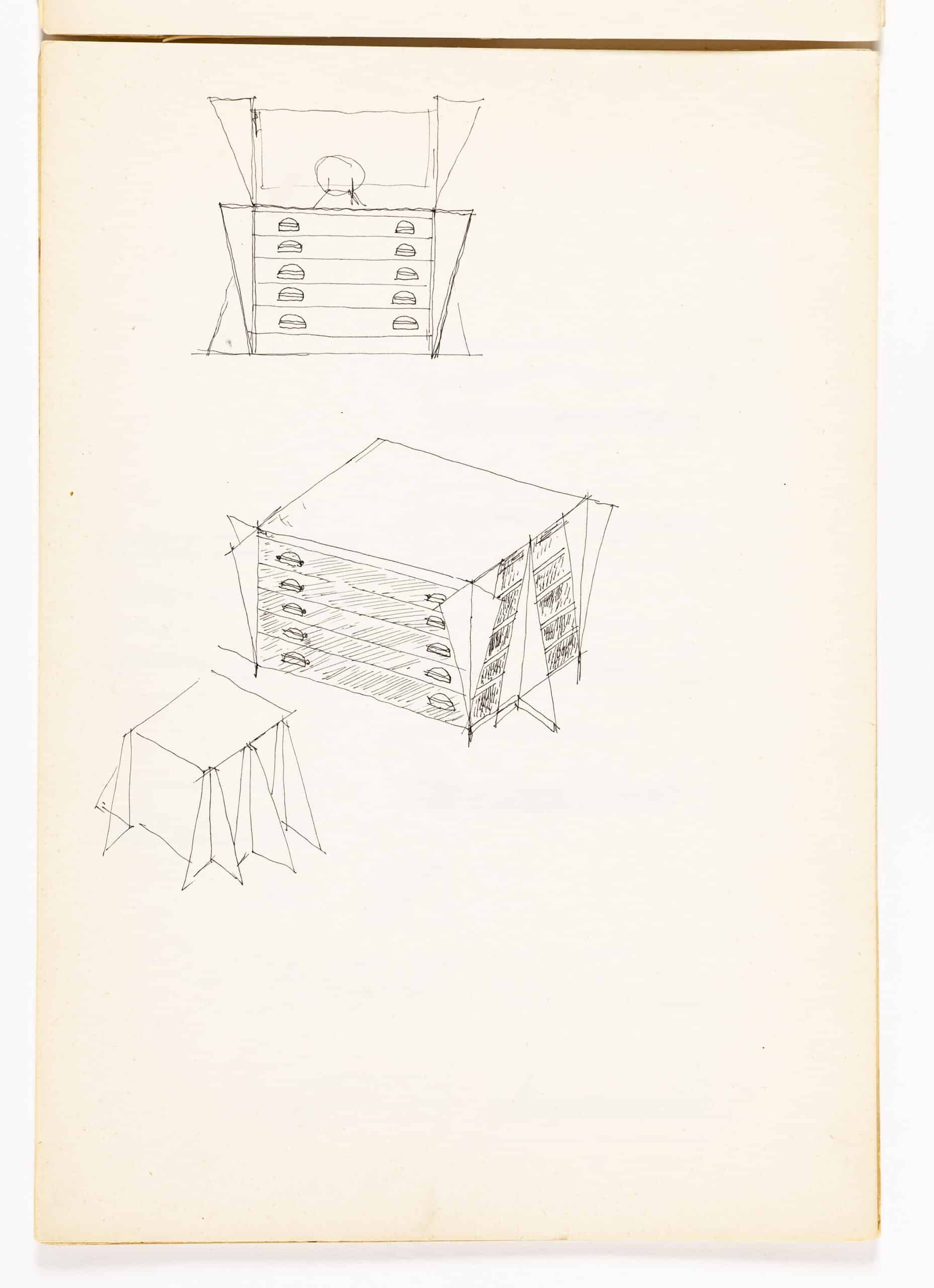
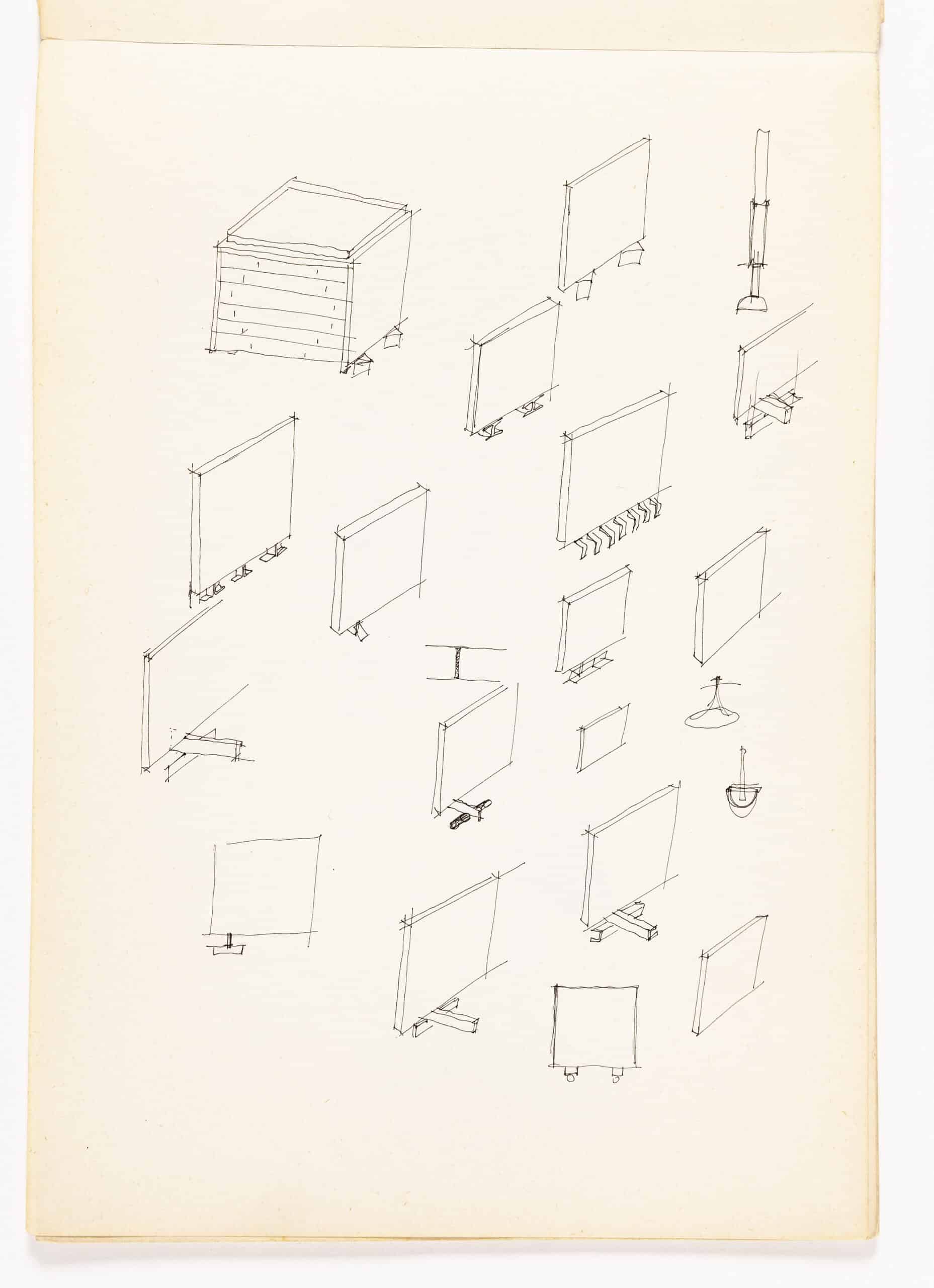
Model 161/2 of a Blocco Schizzi sketchbook, which documents focused work on an exhibition display and the design of a cabinet. It opens with a series of drawings for a display, moving from perspective, plan, cross-section, elevation, to details of its materiality (wood, laminate, plastic, and mirrors). It moves between the display and the designs for a cabinet. The cabinet’s form and scale are worked out over many pages; it transitions from a boxy shape with an extended frame to having angular additions, and back to a rectilinear form, lifted by feet. Great attention is paid to the door handles of the cabinet, their form and placement. The handles range from the folded and recessed to one shaped like a champagne cork. The sketchbook concludes with two coloured pencil drawings. One page is loose, and when placed next to the other, it creates a larger drawing of a building’s facade; it is unclear which building this depicts.
DAL TRENO
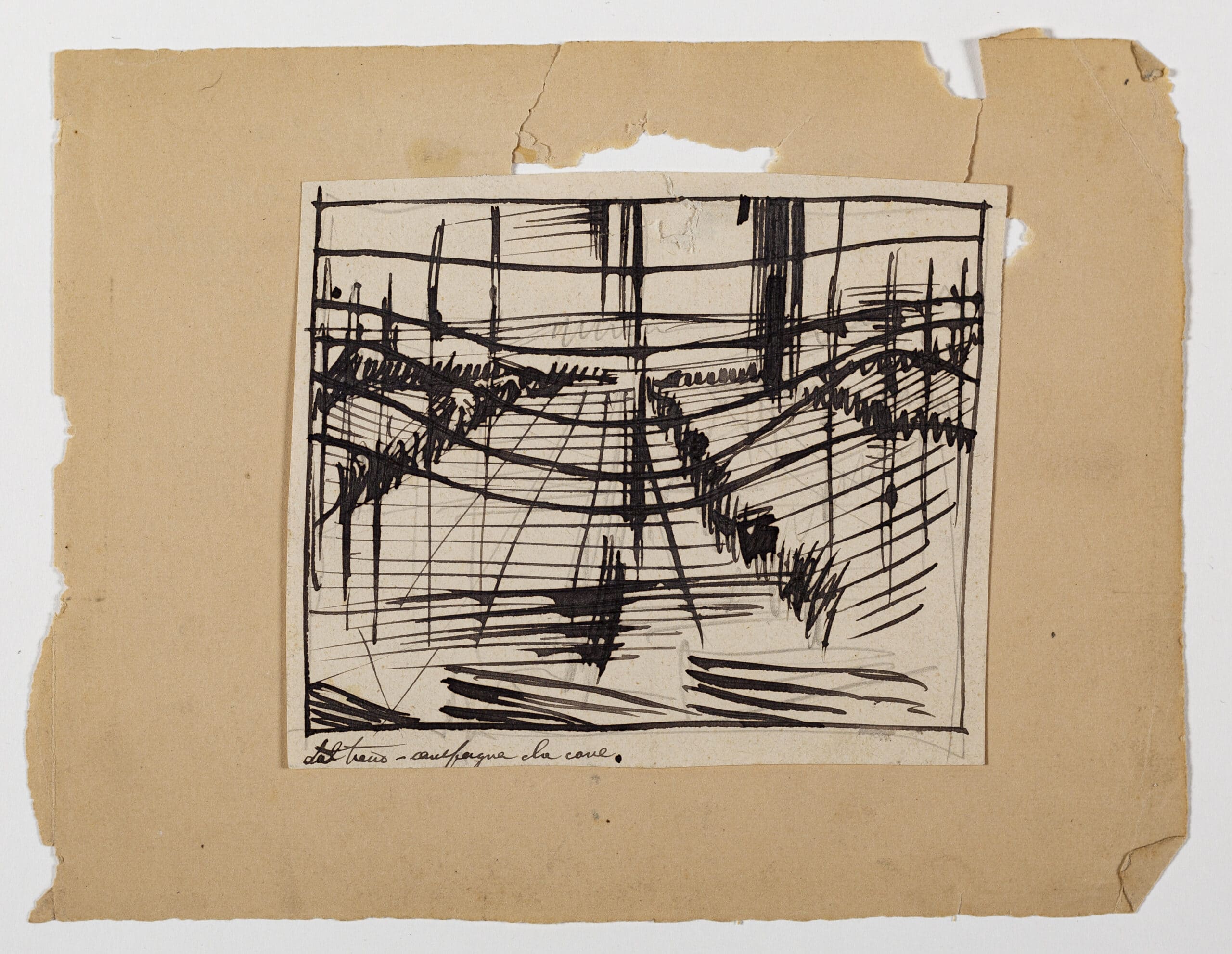
Ink sketch on paper, glued to another sheet with the inscription, ‘dal treno–campagna che corre’ (from the train–countryside that runs). The drawing appears to have an under-sketch in pencil. On its reverse is a note to Mario Zucca.
UN DISEGNO E UN IDEA
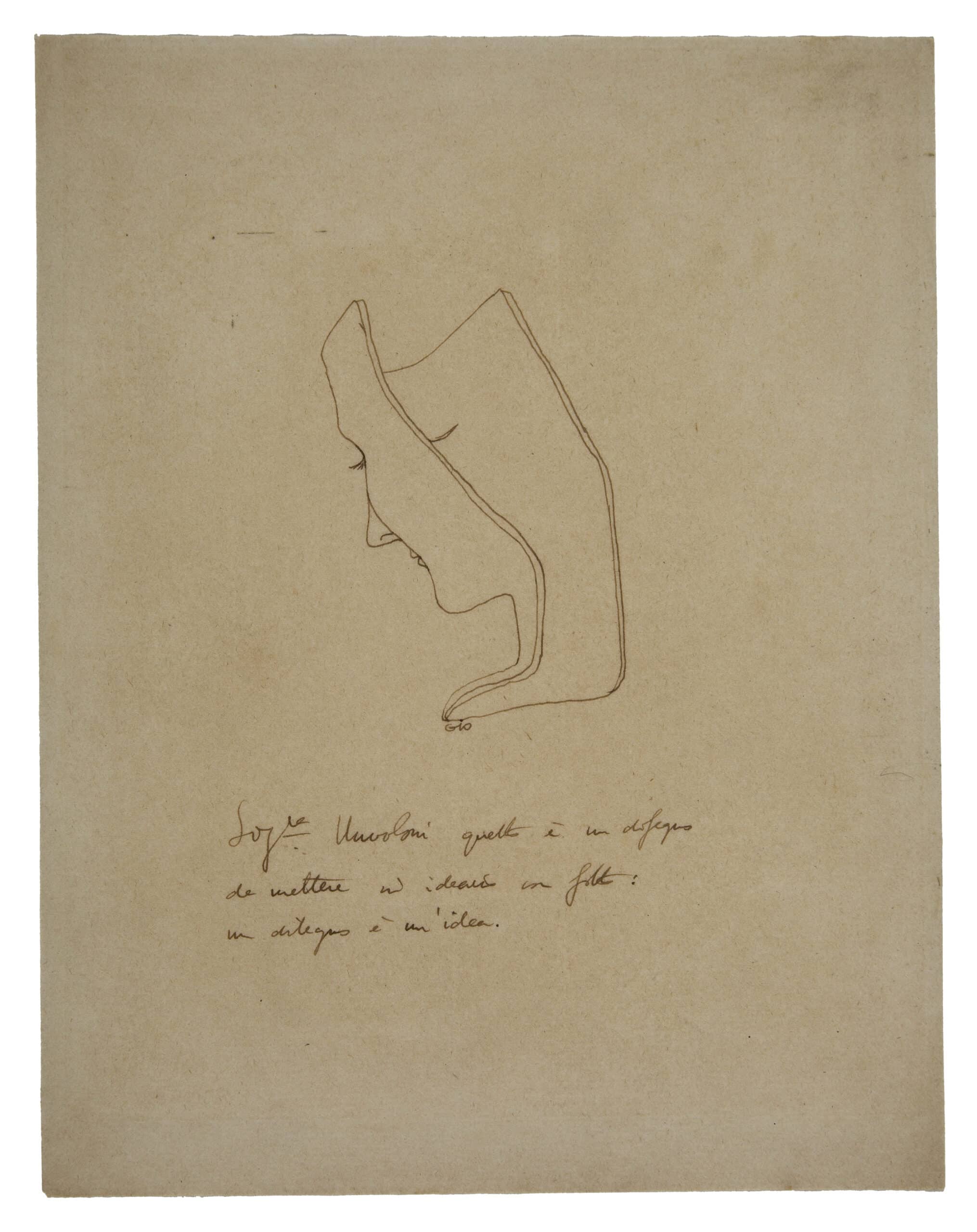
Ink sketch on a single sheet of a woman’s face made to appear like a mask. There is a short note under the illustration addressed to ‘Signora Nuvolone’, stating that this drawing needs to be realised as it is; drawing is an idea. Whether this is an actual letter or a comical fantasy, we are unsure–her name translates to big cloud.
DESIGN FOR KITCHEN FURNITURE
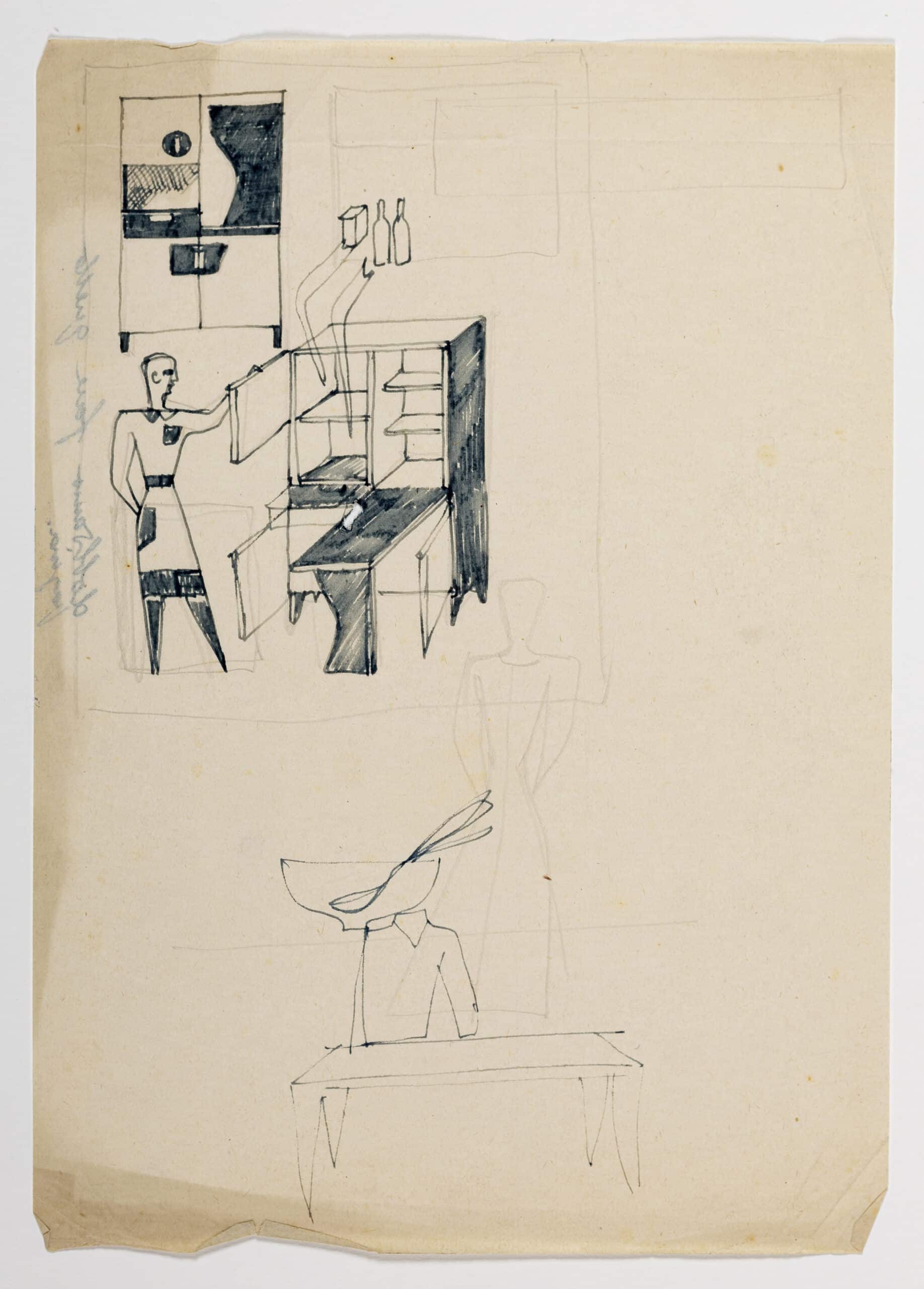
A single A4 sheet that refers to Ponti’s kitchen furniture design. It shows a figure demonstrating how to use a modular cupboard. The elevation is shown above the diagram with floating bottles and a box ready to be put into the cabinet. Below is a lighter pen sketch of a torso with a bowl and spoon for a head at a distinctly Ponti-shaped table–in its domesticity, it encapsulates one end of Ernesto Roger’s slogan, ‘dal cucchiaio alla città’ (from the spoon to the city). On the verso of the sheet, it reads, ‘dobbiamo fare quello pagina’ (we have to do that page).
LETTERS
LETTER TO LEONARDO LOCATELLI, 1928
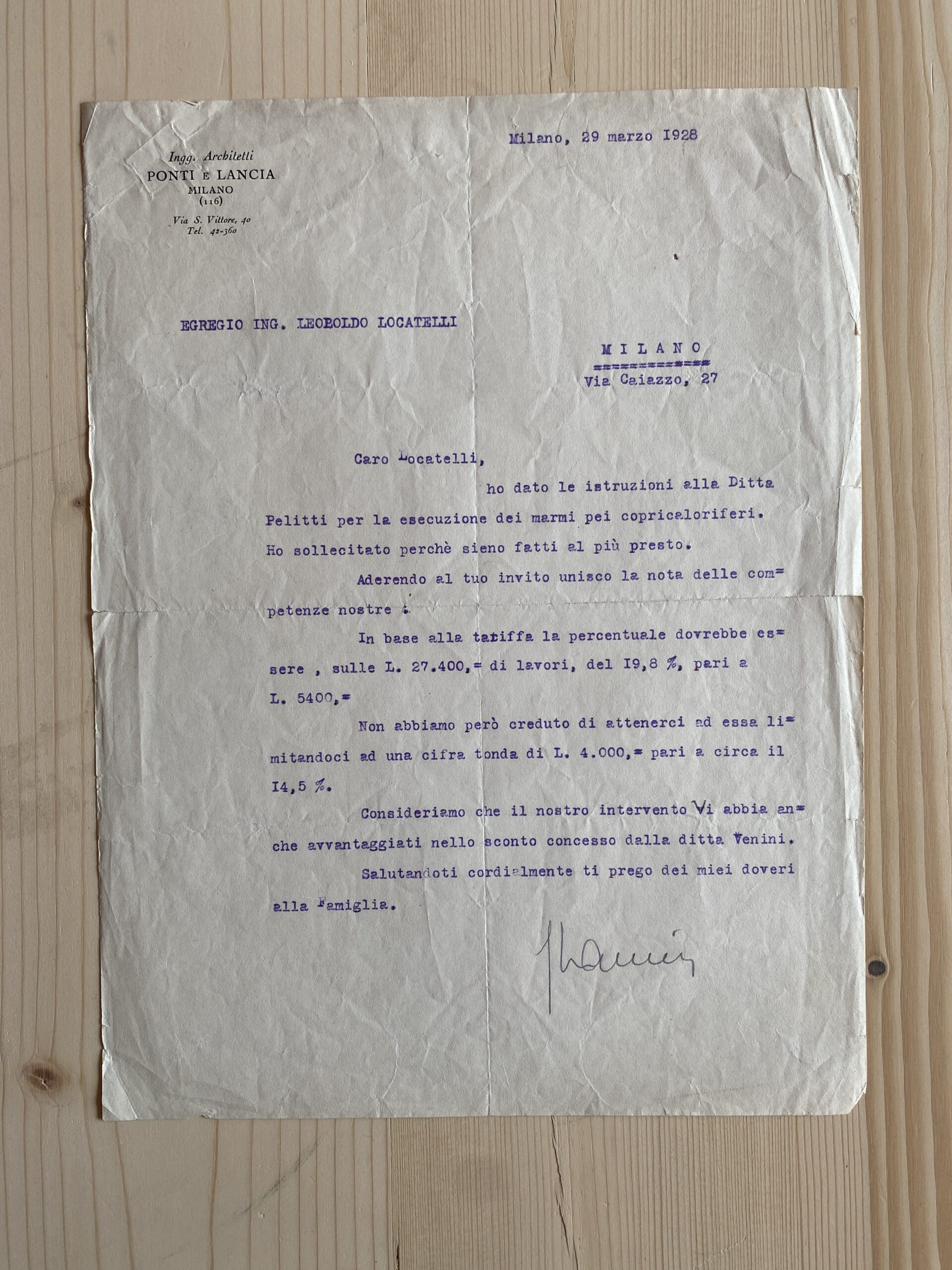
In 1921, Ponti set up his practice with fellow architects Mino Fiocchi and Emilio Lancia, working together until 1927, when Fiocchi left the partnership. From 1927 until 1933, they operated under Studio Ponti-Lancia. This formal letter to the engineer, Leonardo Locatelli, is signed by Lancia and discusses the costs of labour and the percentage of discount they are able to offer him on a residential scheme. The project is unknown but is dated 29th March 1928; it is then plausible that the letter refers to their housing project on Via Domenichino.
LETTER TO GIUSEPPE SANTOMASO, 1942
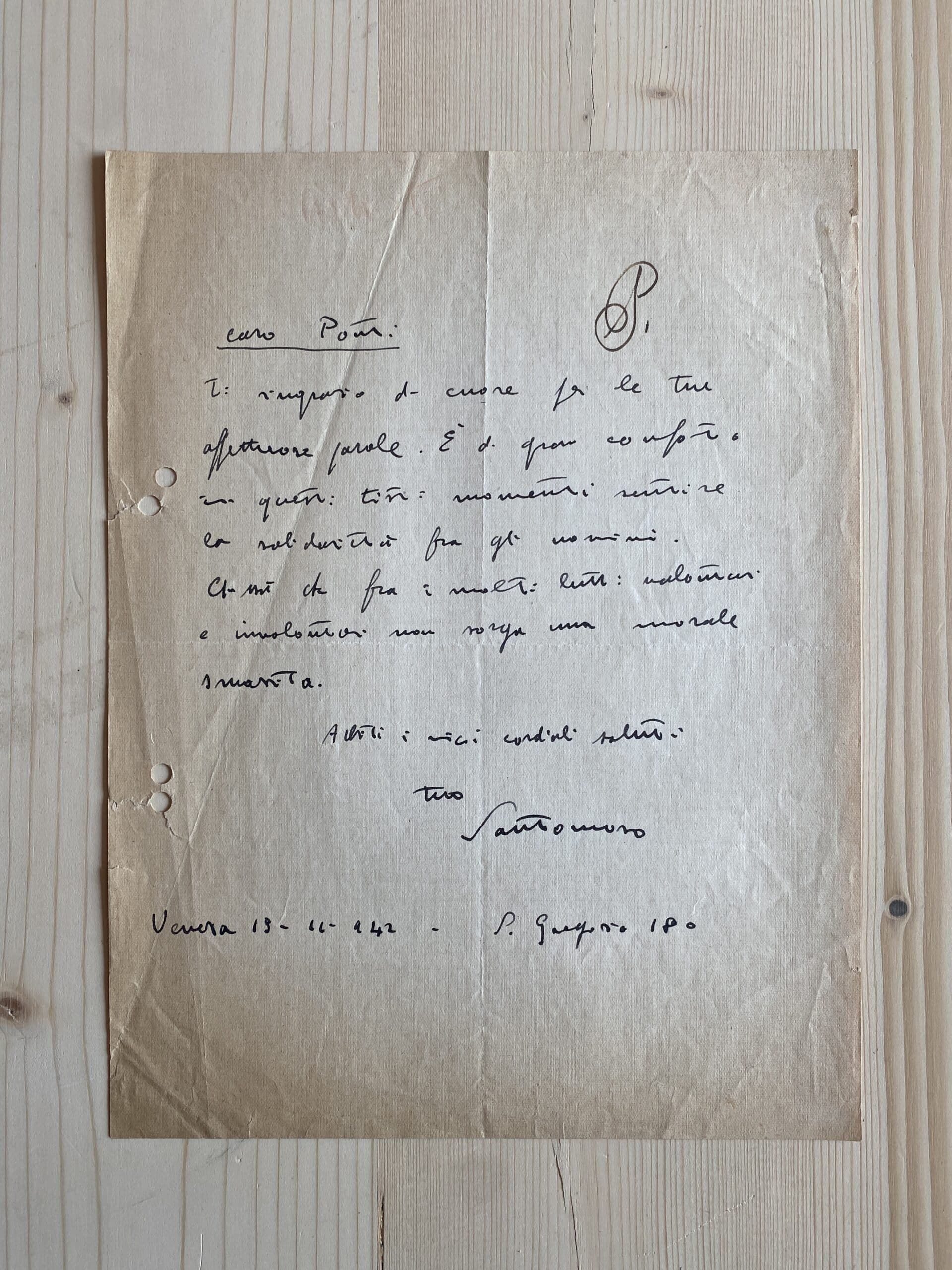
A letter to Ponti from the ceramicist and sculptor Giuseppe Santomaso. He thanks Ponti for his help and affectionate words regarding an issue he is having, and remarks on the feeling of solidarity among the people when morality has been lost. This event in Santomaso’s life is unclear but is dated 13th November 1942, sent during World War Two. Ponti had a close relationship with many of the craftsmen he commissioned, and he had worked with Santomaso on the Palazzo del Liviano at the University of Padua.
LETTERS TO DARIA GUARNATI, C.1950-1967
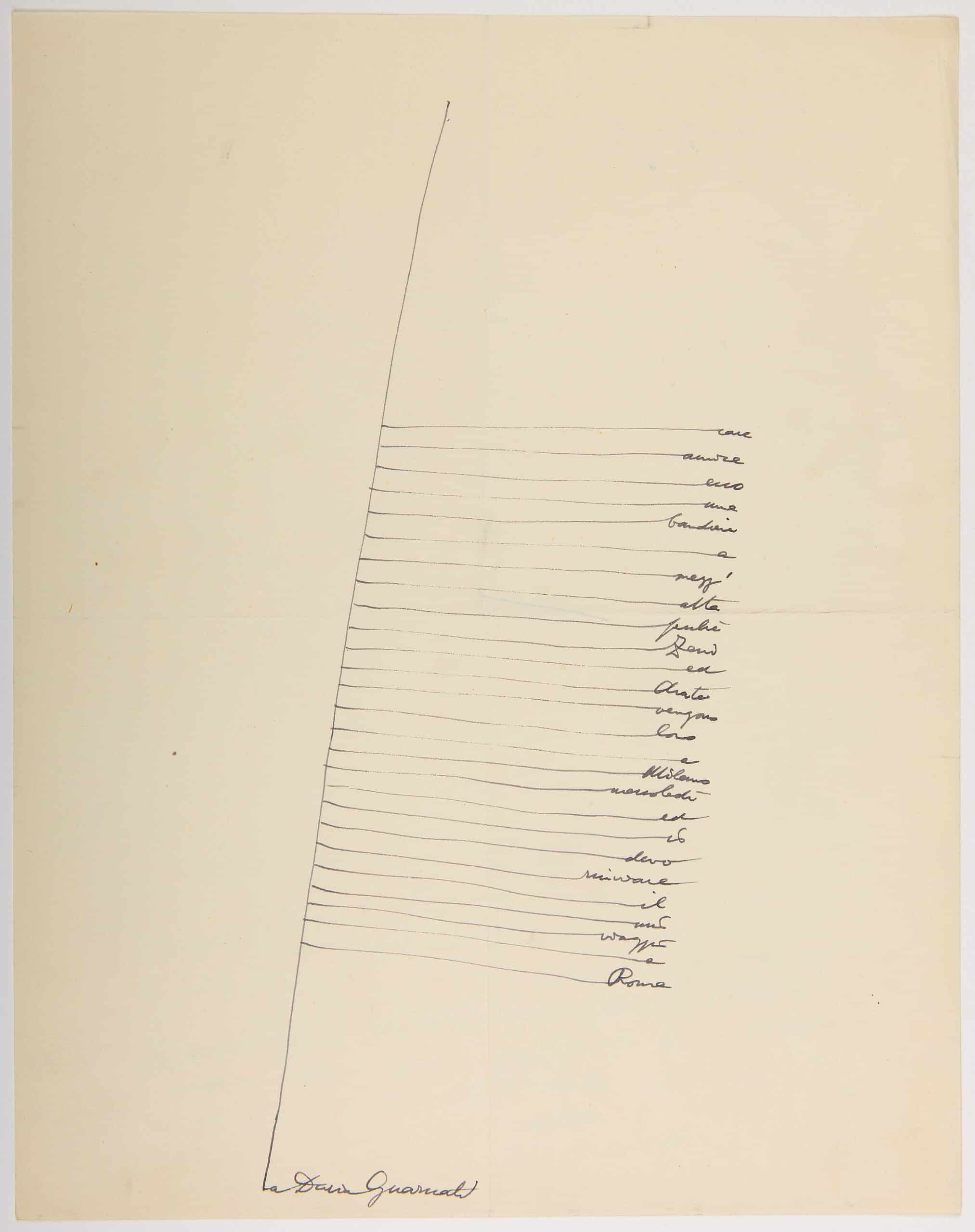
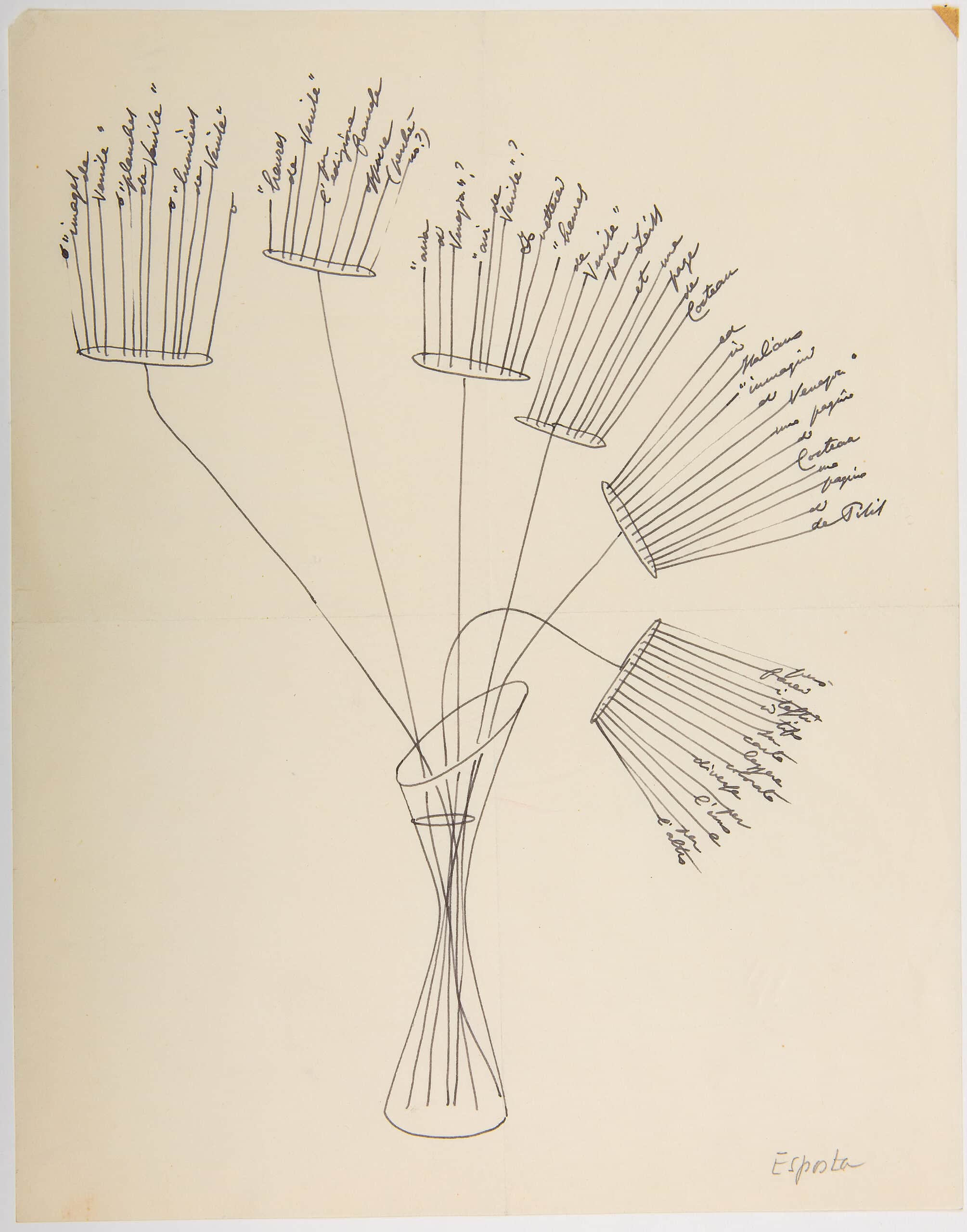
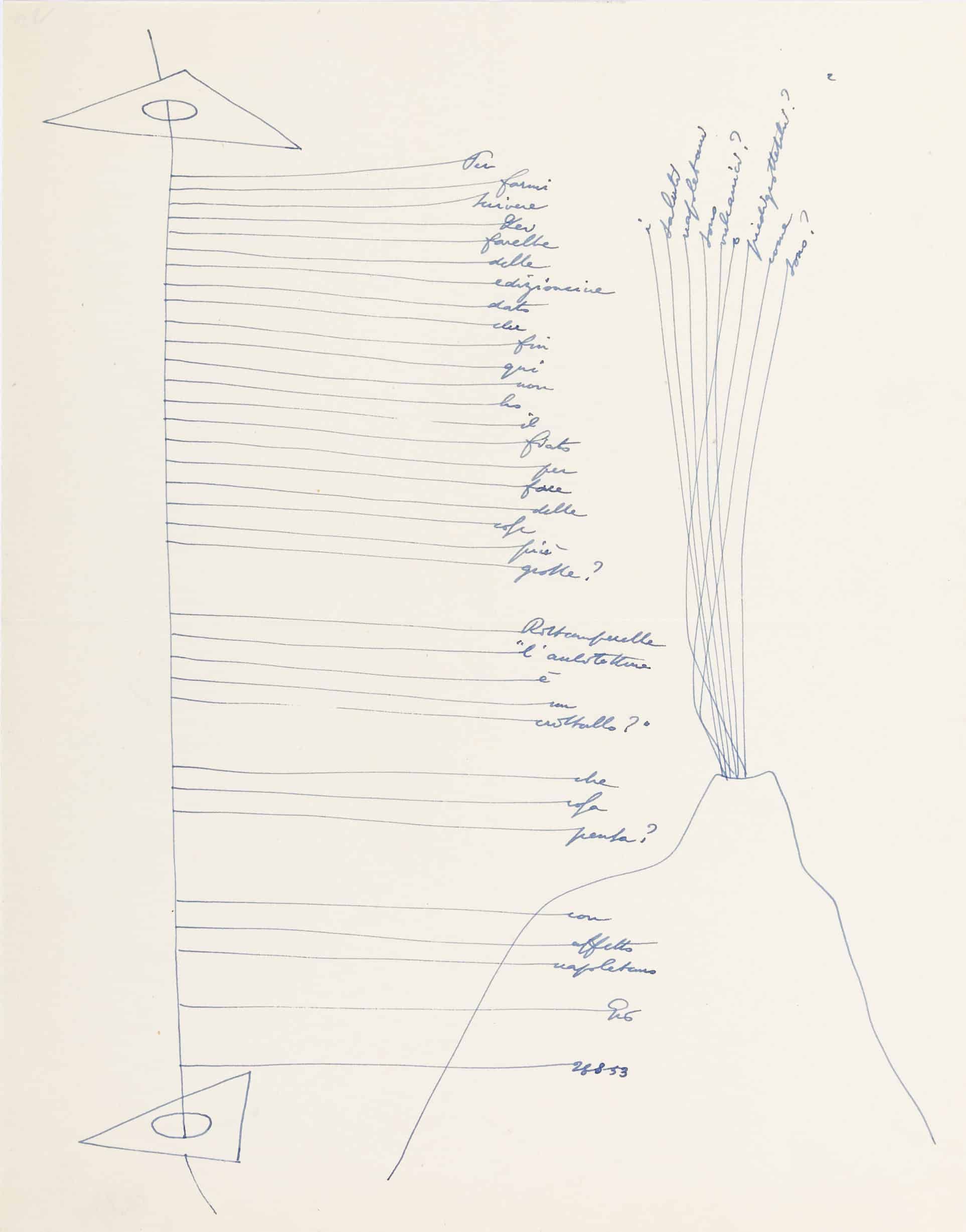
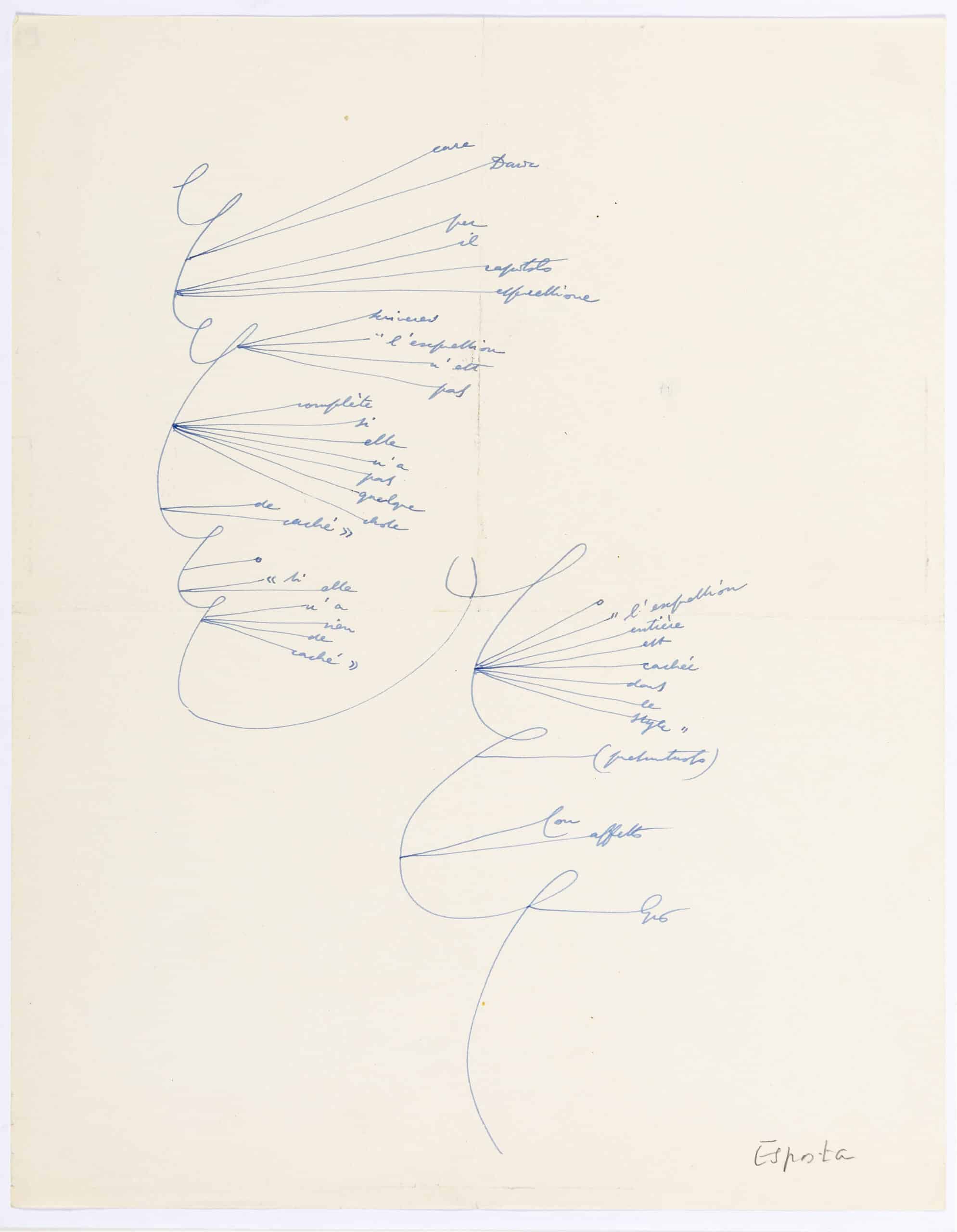
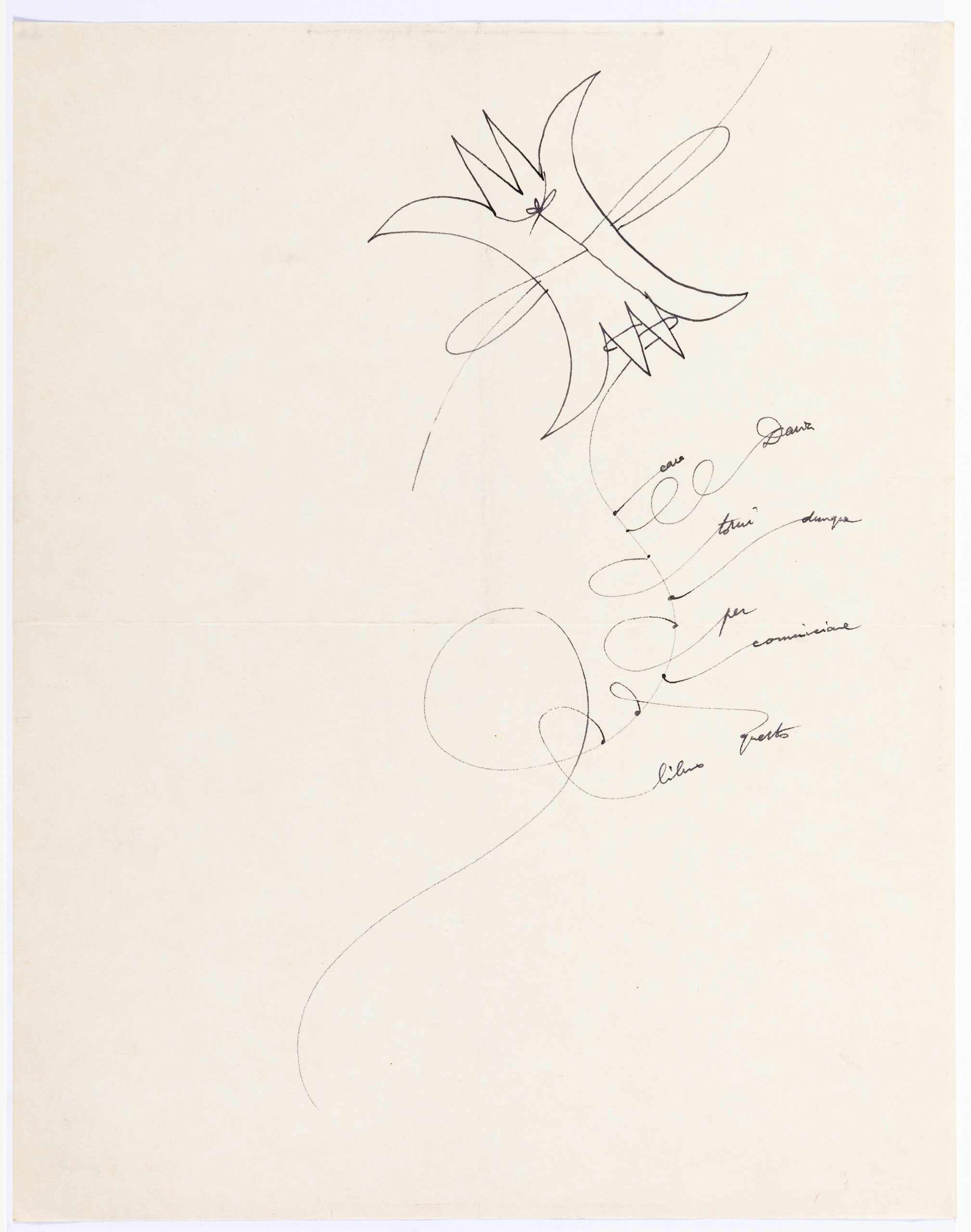

Ponti was known to be prolific in his letter writing, and held within the collection are 25 letters from Ponti to his publisher, Daria Guarnati. While some of the letters deal with the publication of Aria D’Italia, they are mainly exchanges between friends, informing Guarnati about his family and asking her to visit their home. They are written in a sinuous script, with words and illustrations blurring into one. A letter about an upsetting day uses the words ‘a mezz’asta’ (at half-mast), another sent while in Naples, plays with Vesuvius, volatile provocations erupting from it. Joseph Rykwert argues that these letters were ‘always an invention, a concept’. Ponti is playful in his language and makes jokes with Daria, about how she uses blue ink or if he hasn’t asked her enough to visit him. They are mostly undated, although we can pinpoint one letter to December 1967, an elegant hand balancing a cigarette informs Guarnati of a gift in a cloud of smoke, the book Nuvole sono immagini (Clouds are images). The publication was conceived as a gift for Christmas and New Year, entrusted only to Ponti’s friends.
TWO SKETCHES FOR A BEDROOM AND LIVING ROOM, C.1940
Two A4 drawings for the design of a residential interior. The first sheet is divided into three; 1, shows two options for the arrangement of a bedroom with a walnut frame sofa, bed, and wardrobe, they differ through the addition of a dressing table and chair; 2, lists the furniture of the living room, including a chaise-longue and drinks cabinet; 3, states the bedroom should stay as indicated. At the top of the sheet is written Forn and Colombo, which could refer to Antonio Fornaroli and Ariberto Colombo, for both of whom he designed furniture. The other sheet is drawn on both sides, the first in pen, with studies of various cabinet designs, tables, and corner seating. On the reverse are pencil sketches of cabinets and a few dining chairs.
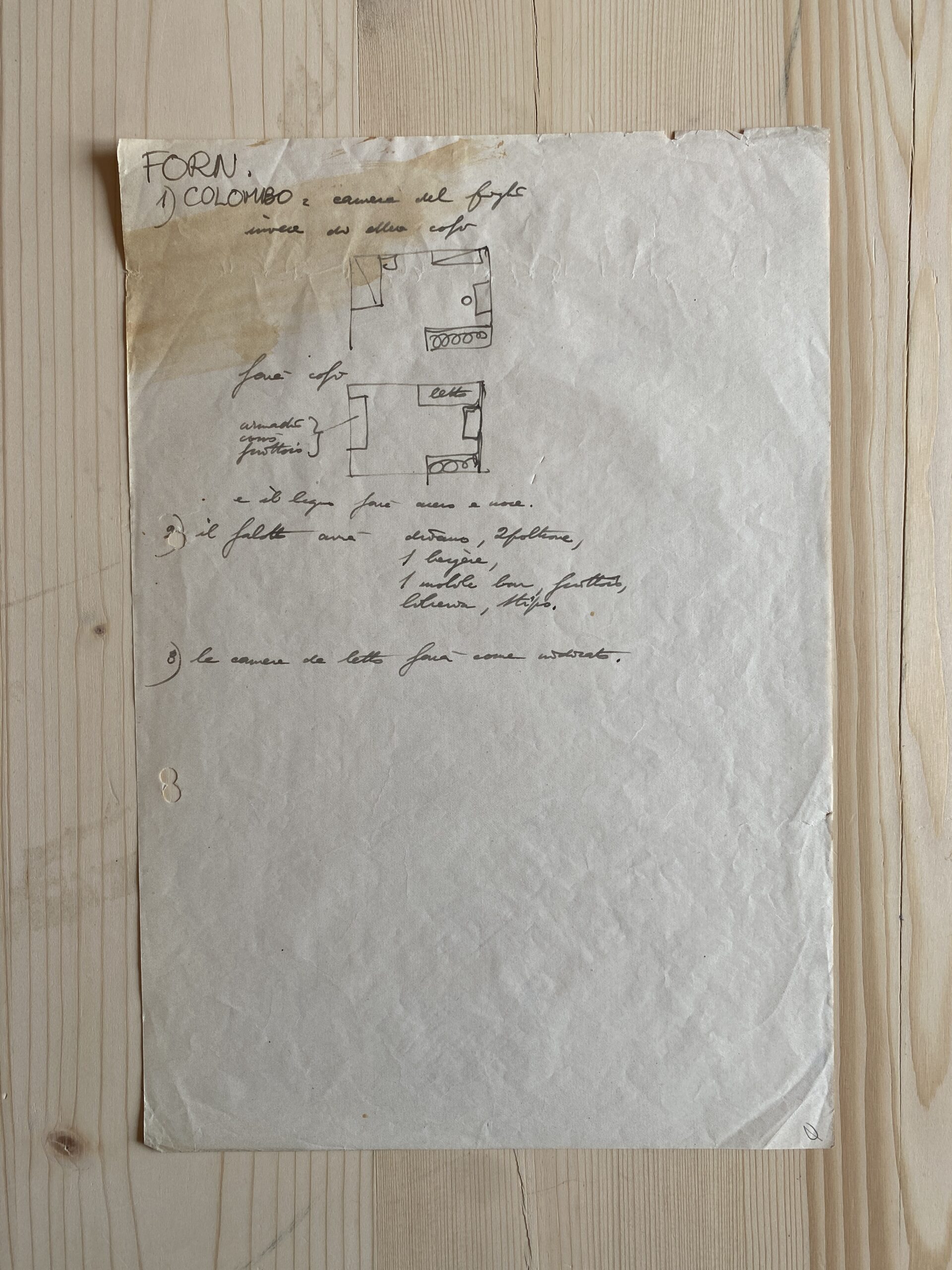
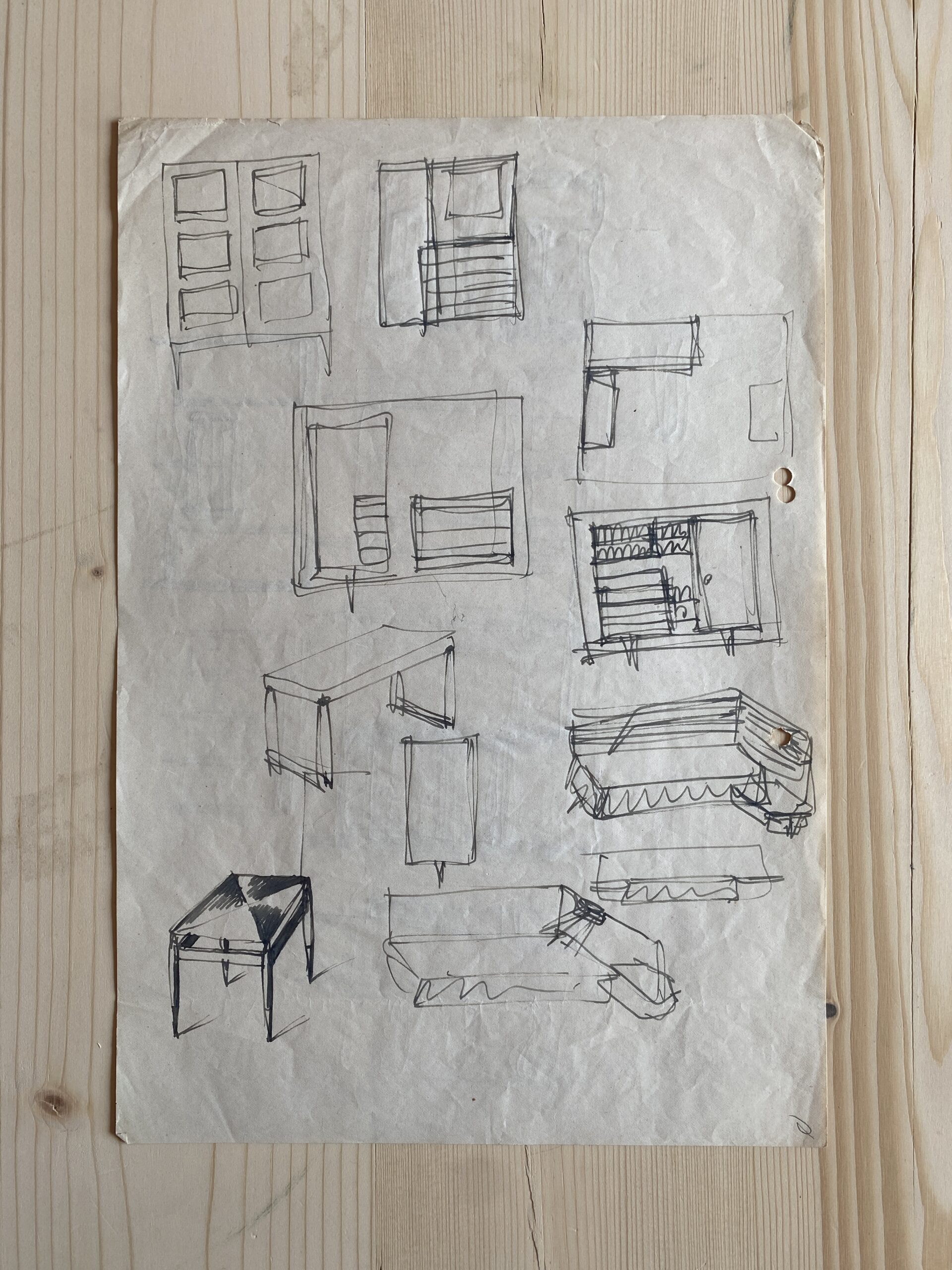
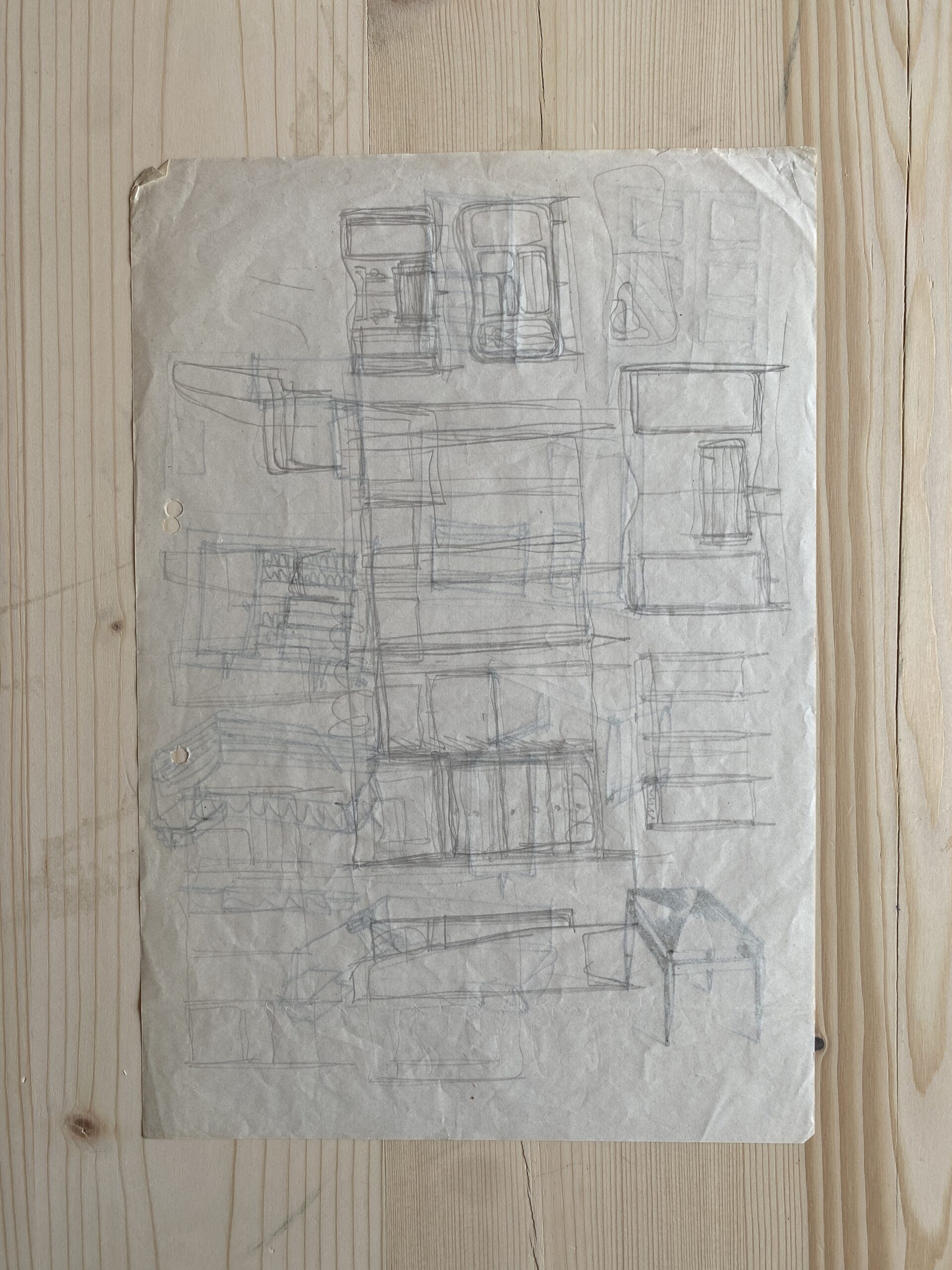
MONTECATINI, MILAN
SKETCH OF SECONDO PALAZZO MONTECATINI, 1952
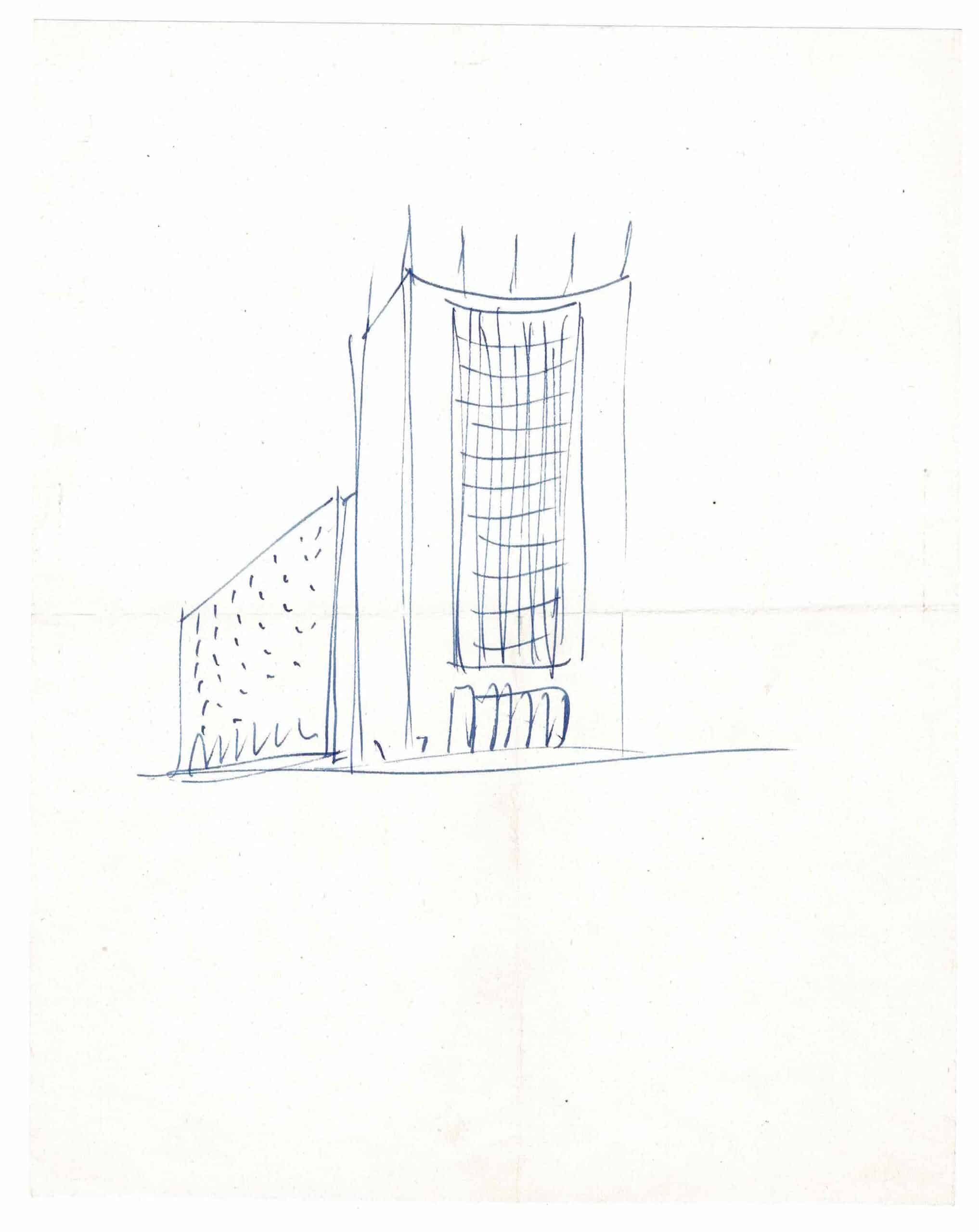
Single sketch in blue ink on a sheet of A4 paper. Perspective view of the curved facade that faces Largo Donegani in Milan, opposite the first Montecatini Palazzo built in 1936. The drawing captures the essence of the project, the monumental curved facade, with its spires and repetitive windows of the block behind.
SKETCHES FOR MONTECATINI STAIRCASES
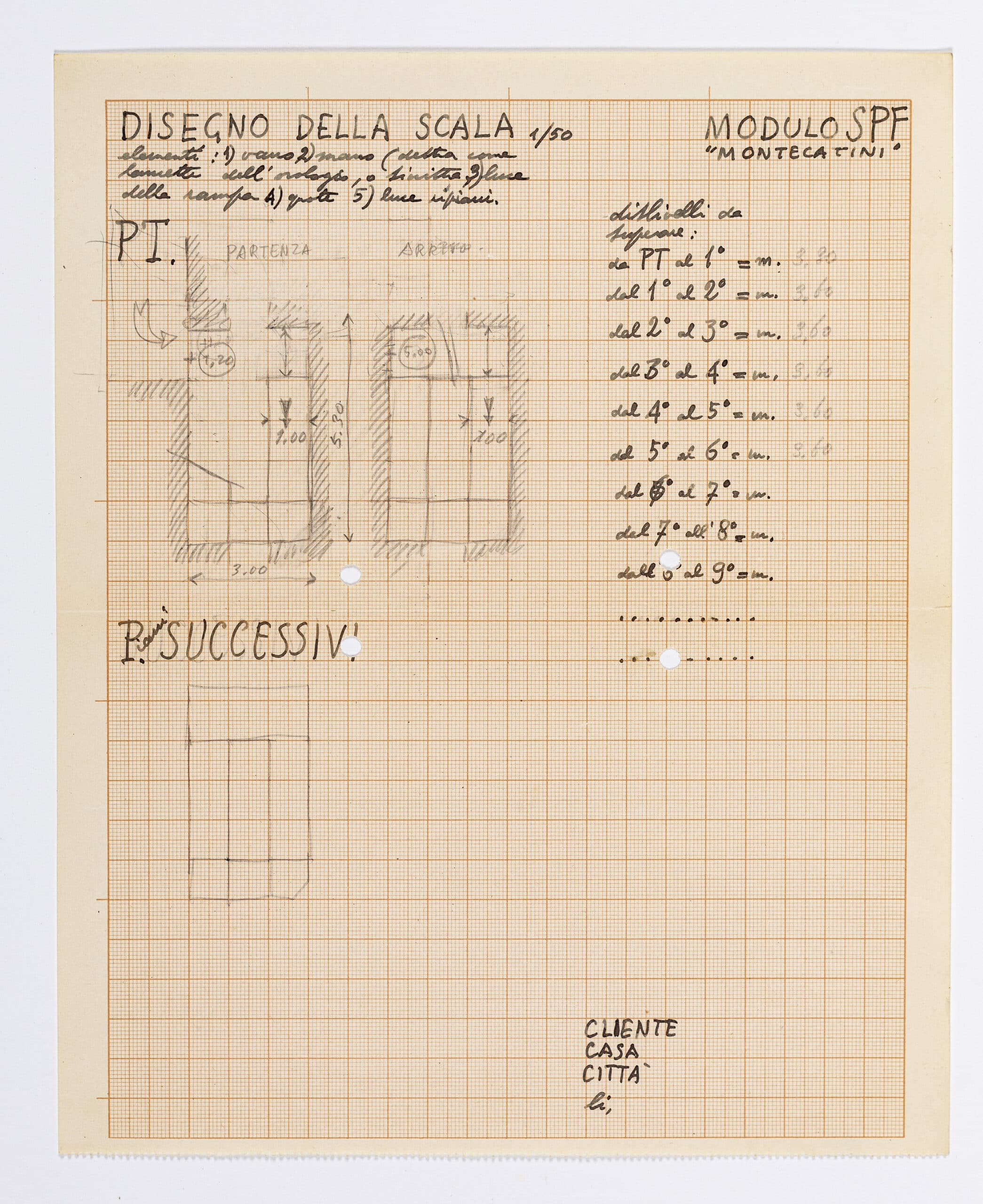
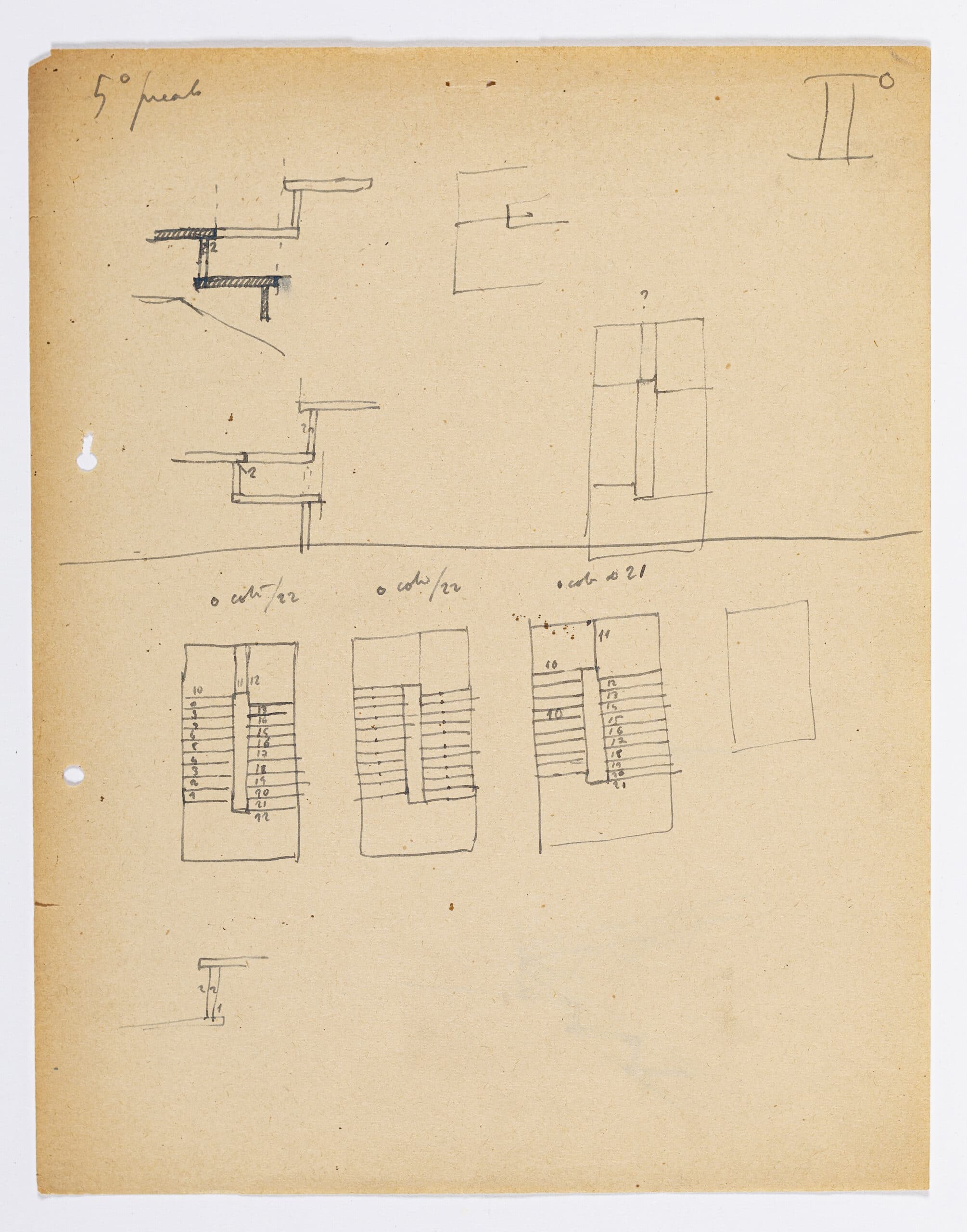
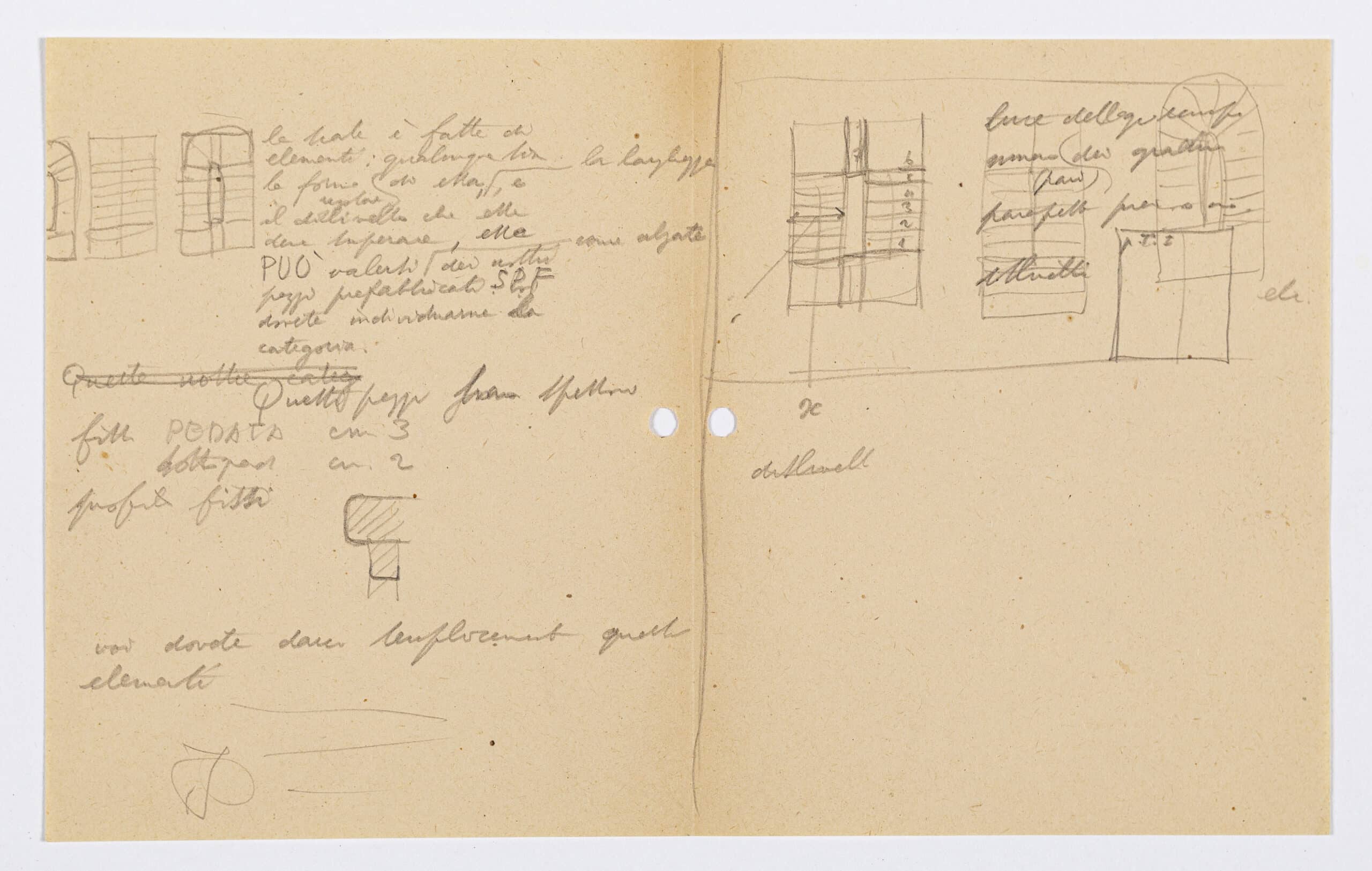
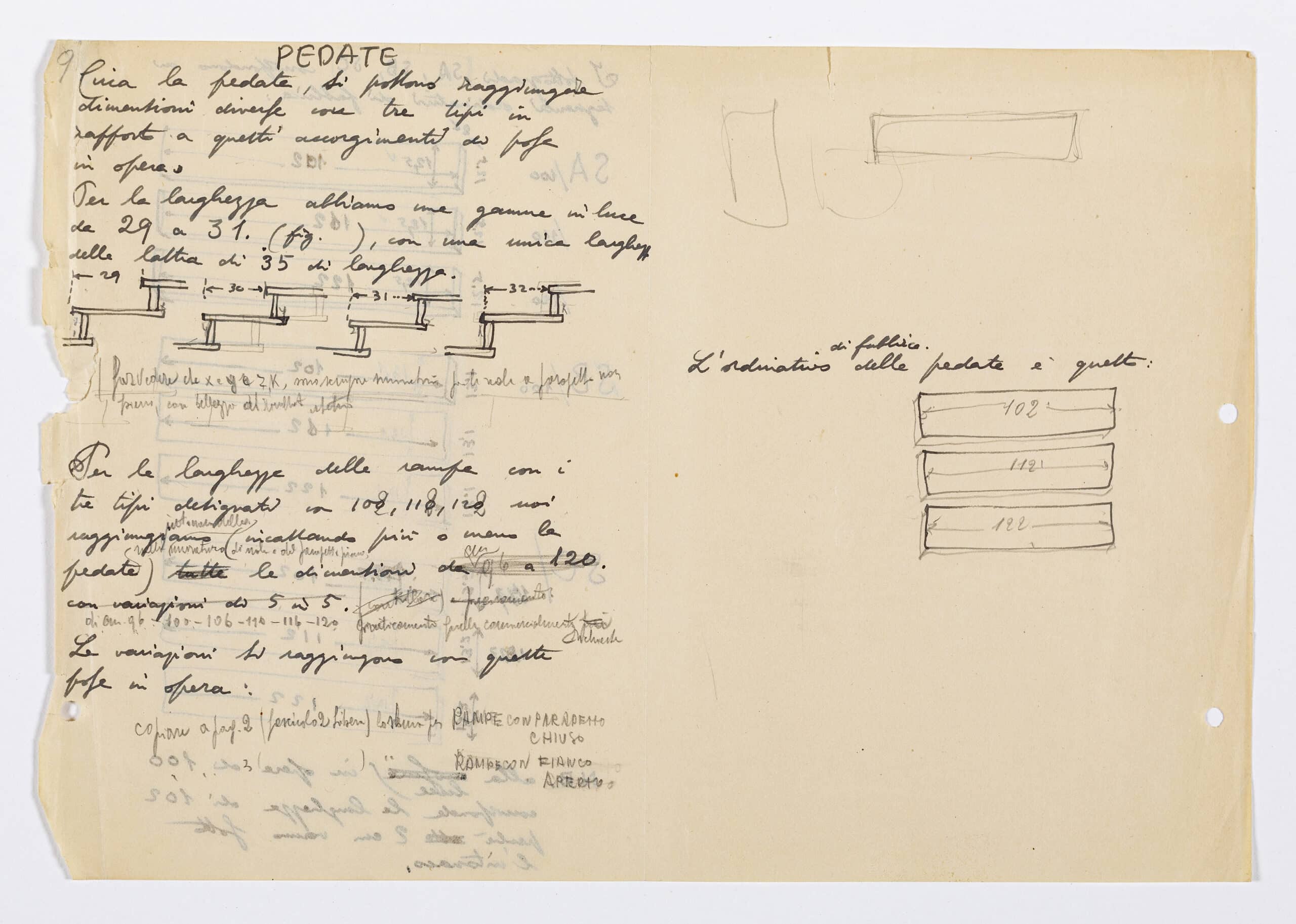
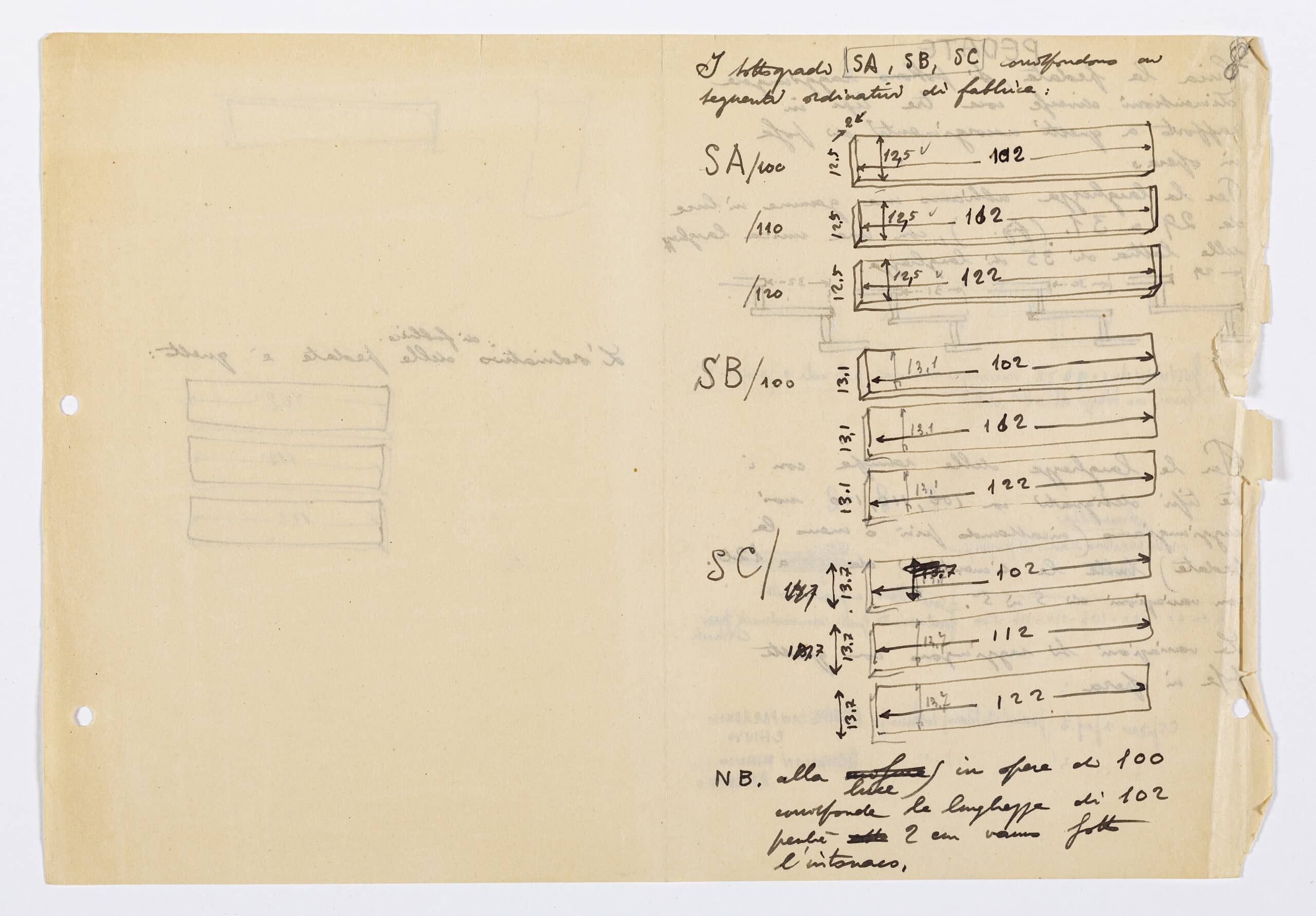
A group of drawings which relate to a prefabricated system of staircases for the Montecatini building, although it is unclear which one. The group comprises 15 sheets of various sizes, each drawn on the recto and verso, containing sketches, notes, and measurements of the ‘SPF’ model. Ten sheets are on the same paper and show, through a mixture of pencil and ink sketches, the process of formalising the ‘model’ for the staircases, taking into account each step’s length, depth, and width. Two smaller sheets offer notes and measurements on the length of railings and the depth of the stairs in conjunction with the gradient of the staircase. Another sheet with Ponti’s writing on explains that the stairs are made of elements; you use the model that has been devised, SPF, but to do so, you need to input the measurements to define the elements. There are two sheets which offer the key to reading the group as a whole. One which sits apart from the others, drawn on orange graph paper, of the ‘Disegno della Scala – Modulo SPF “Montecatini”’ (Design for the stairs – Model SPF “Montecatini”). It lists the measurements for each floor’s staircase, with a pencil diagram of how the stair develops. The other key drawing is entitled ‘Pedate’ (steps), and details SA, SB, and SC, the three types of steps.
STUDIES FOR BUILDING WITH AUDITORIUM, 1952
Drawn on the recto and verso, the pencil studies are most likely a very early design for the Institute Italiano di Cultura (Fondazione Lerici) in Stockholm. It is one of only two buildings where Ponti designed an auditorium, the other being in the base of the Pirelli Tower in Milan. As it is not a common typology for him, we see Ponti’s dedication to figuring out their form. On one side, we see three iterations of the wedge-shaped space in plan, and on the other, a larger plan and a small elevation. The drawing is dated 31st March 1952, before his appointment, but it is possible that this sheet was done in the lead up to securing the job. The shape of the auditorium corresponds to an early model held in the Archivio Gio Ponti.

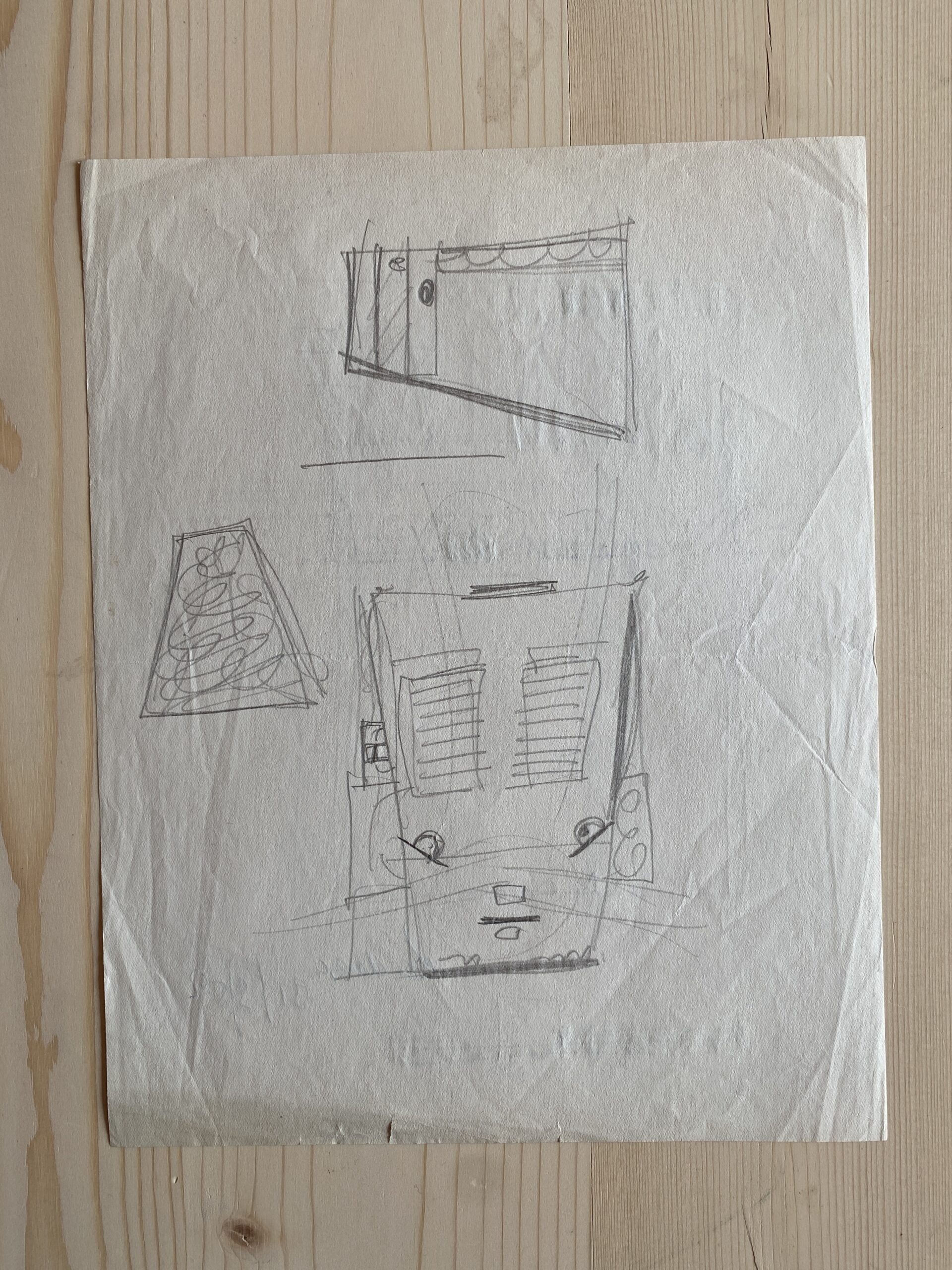
ARIA D’ITALIA: MOCK-UP, 1954
Between 1939 and 1941, the editor Daria Guarnati published seven volumes of a series called Aria D’Italia. Each issue formed a substantial monograph on a distinct facet of Italian life and culture. In 1954, she published a special eighth edition devoted to the work of Gio Ponti. It is structured as a series of visual meditations by the architect on his life and work, traced through the chapters: Accademia, Evocation Mediterranea, Intermezzo, Episodio, Ideario, Macchine, Classicismo, Esperienze, and Opera in Corso. In the possession of Guarnati (until her death) were pages Ponti mocked up for the publication; they do not represent the final book in its entirety but capture his iterative process. Working on a pre-made three-column template, he draws directly onto the pages in a variety of media, including ink, pencil, and watercolour; he redraws his projects and paints his photographs. Text and captions are only represented, cut-out paragraphs from magazines pasted into place–their importance as text is very little, with some placed upside down. The publication was reprinted for Ponti’s first retrospective in the US, a copy of which is also held in the collection.
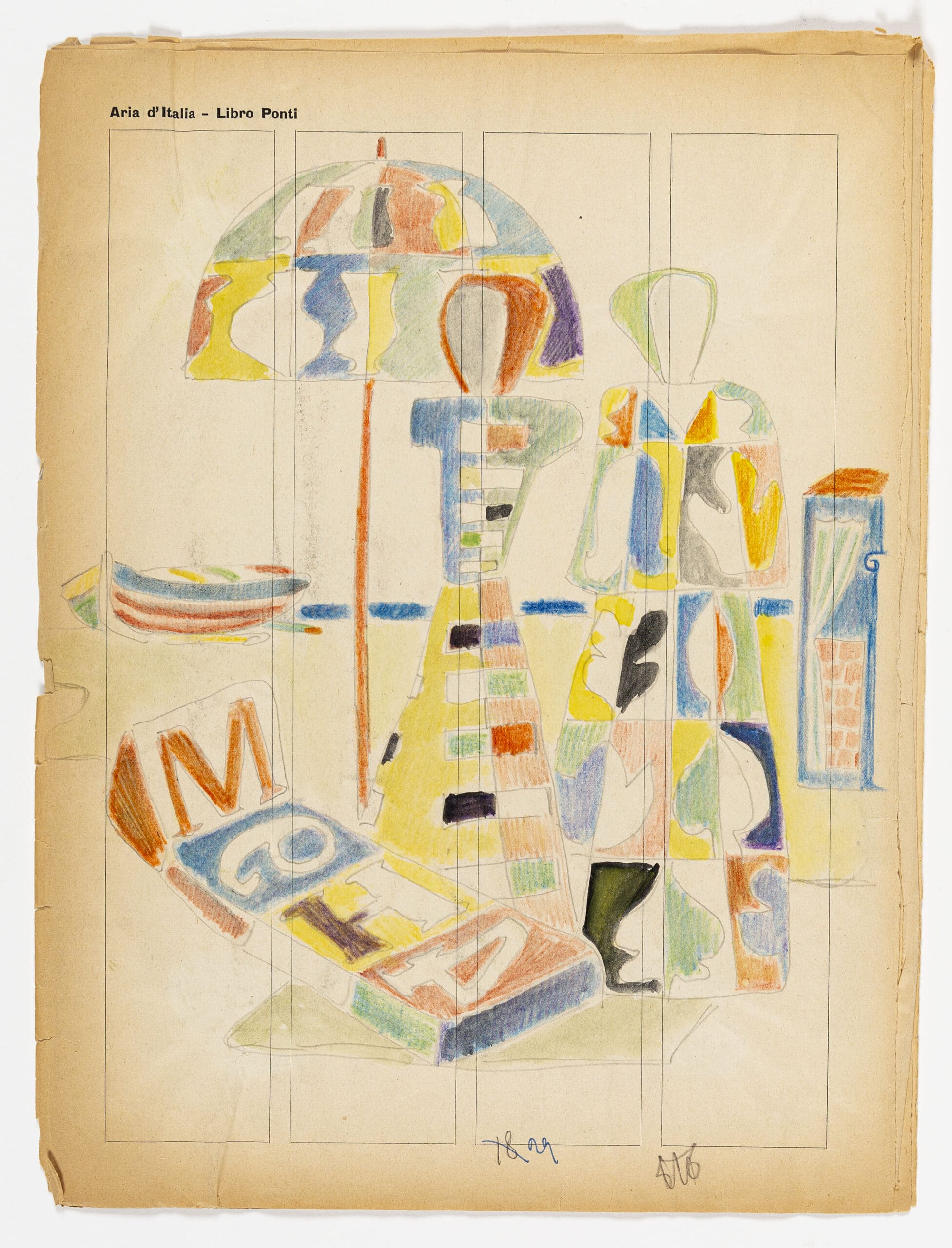
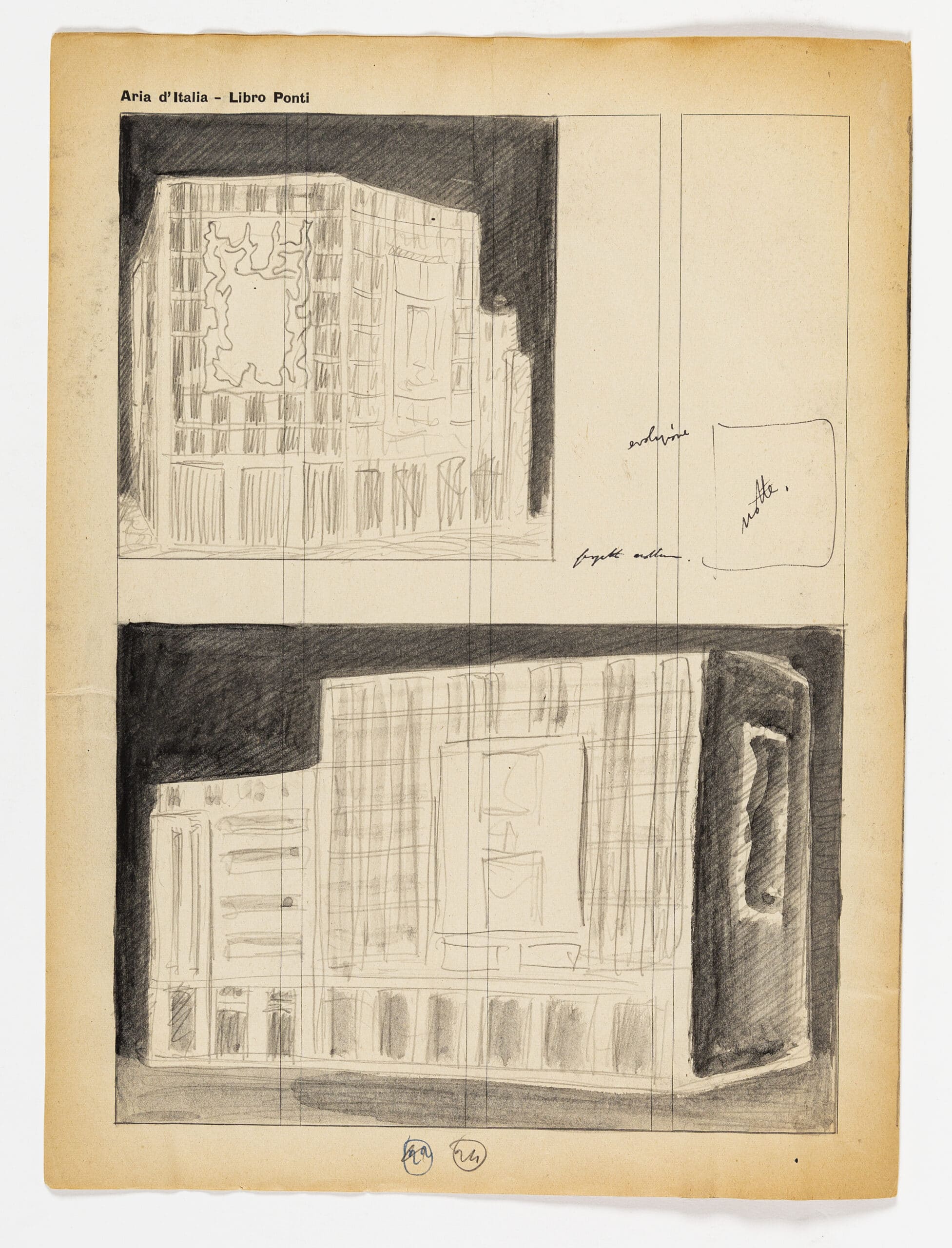
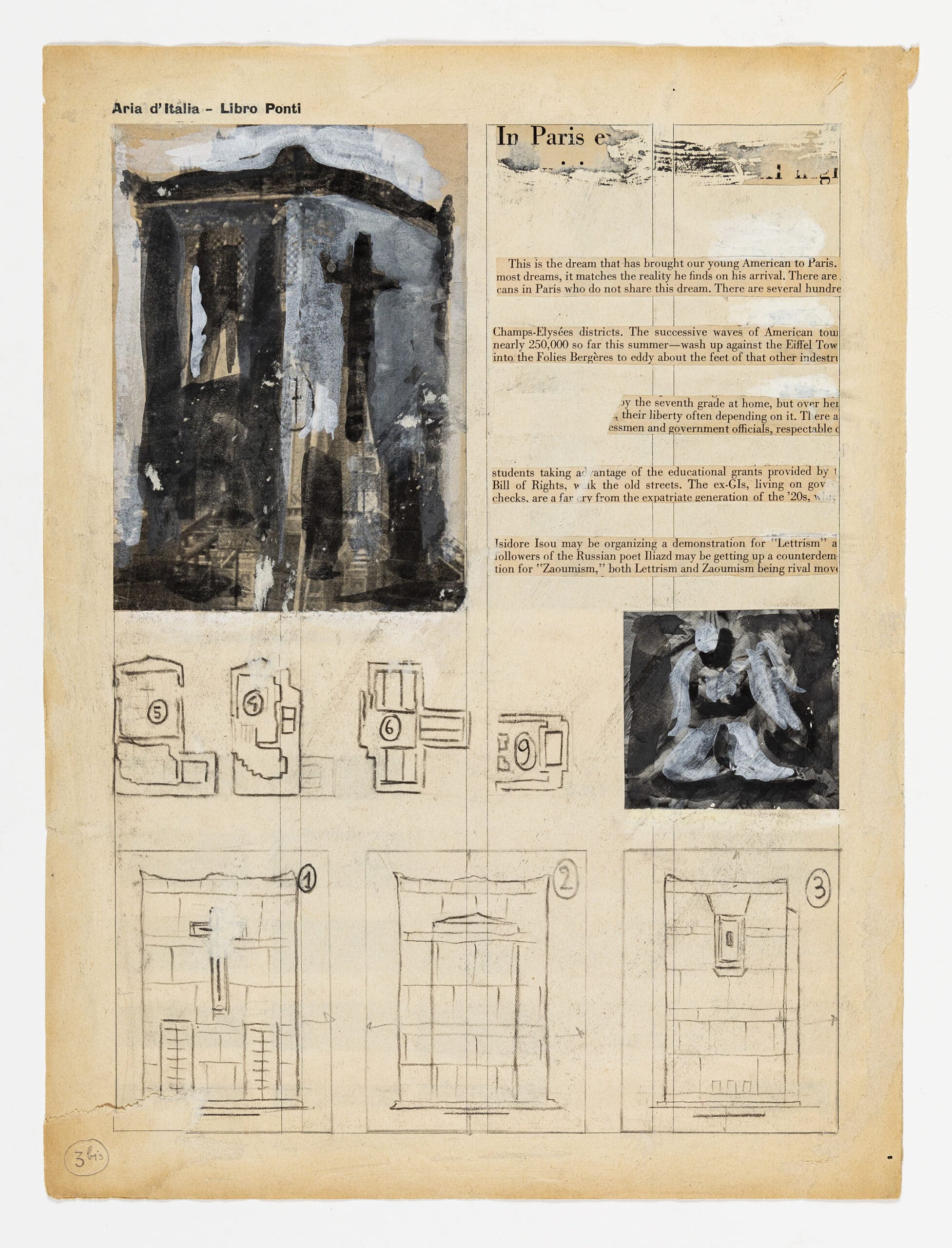
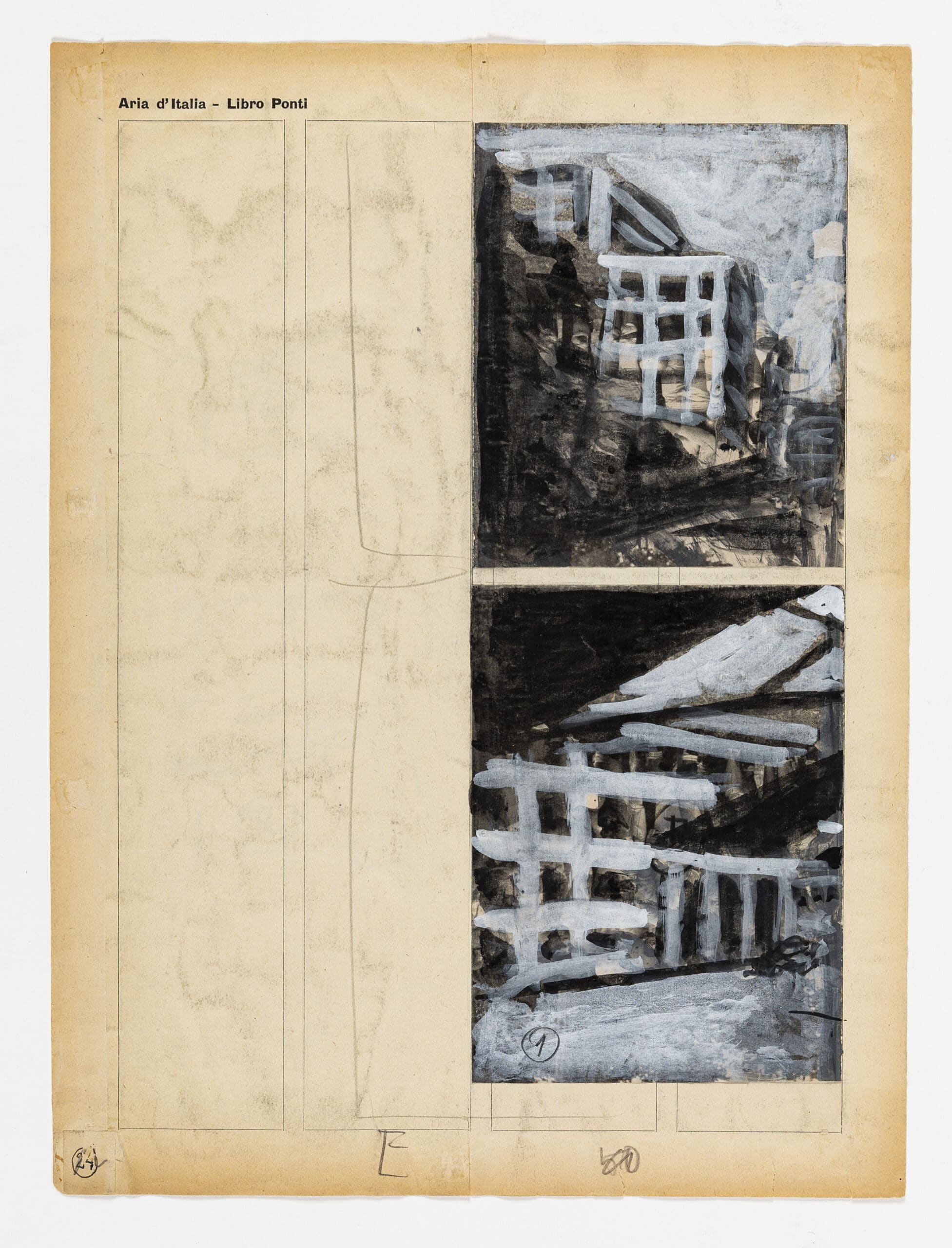
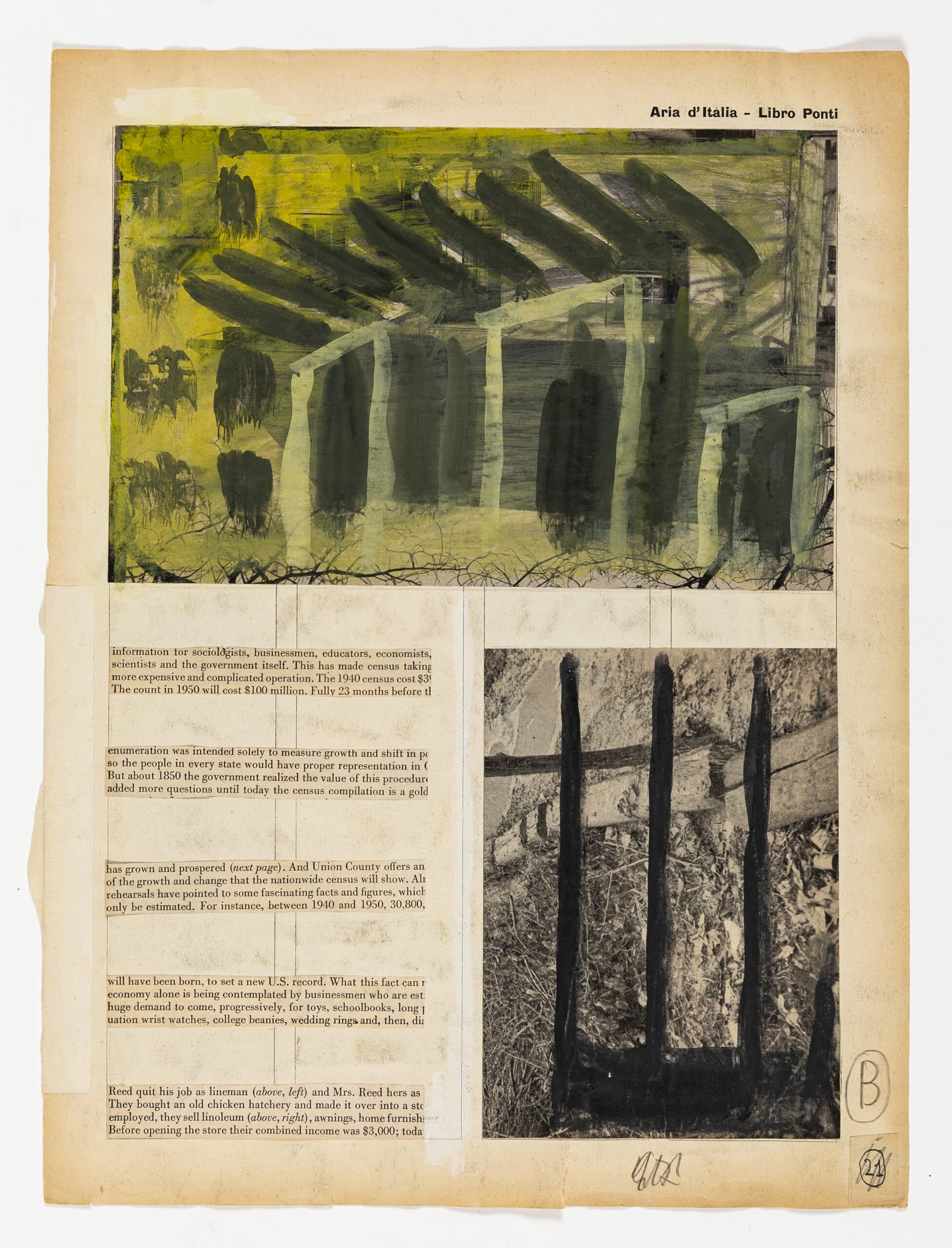
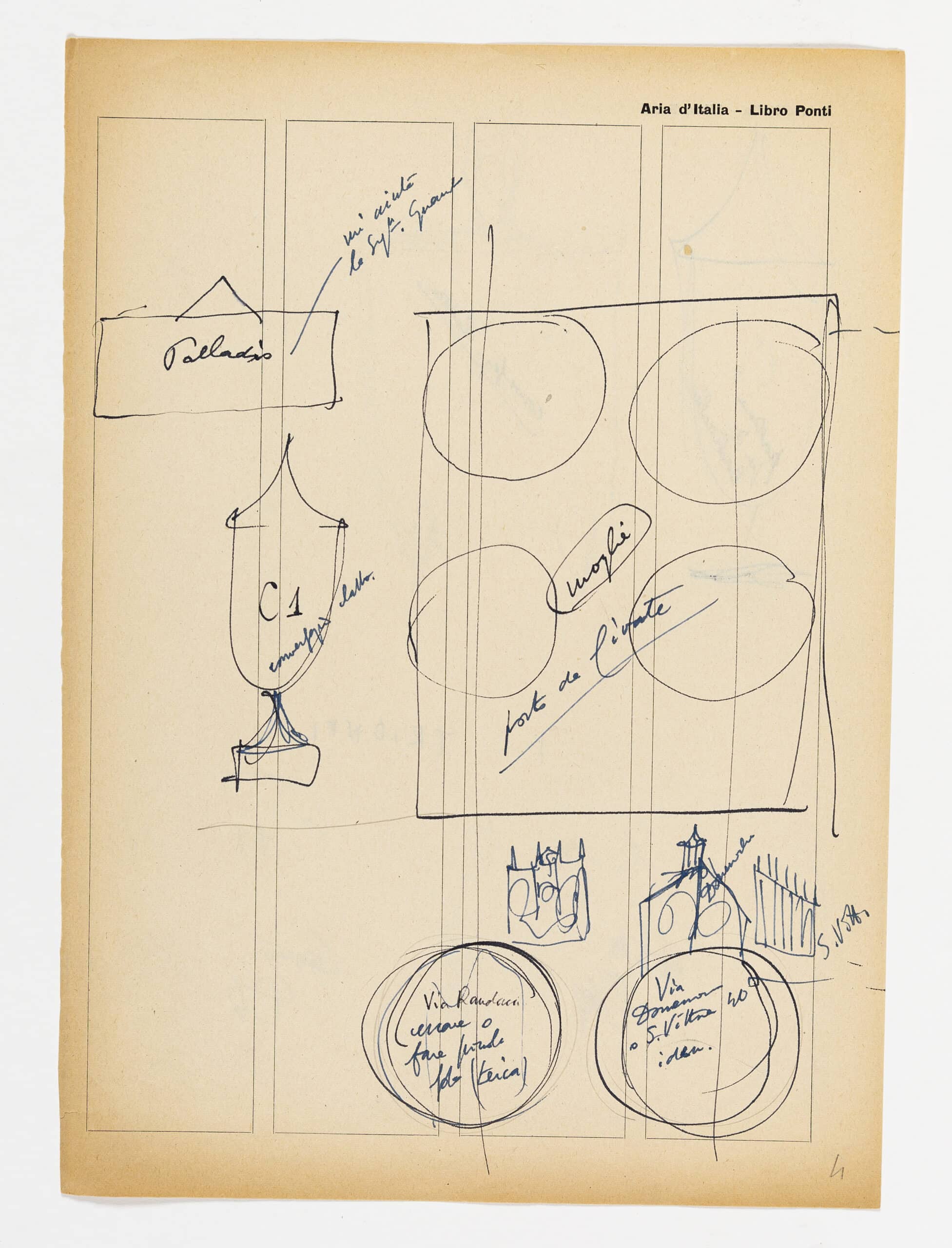
SUPPLEMENTARY MATERIAL
Acquired alongside the letters from Ponti to Daria Guarnati was this small portrait sketch. Its sitter, author, and significance with the letters are unknown.
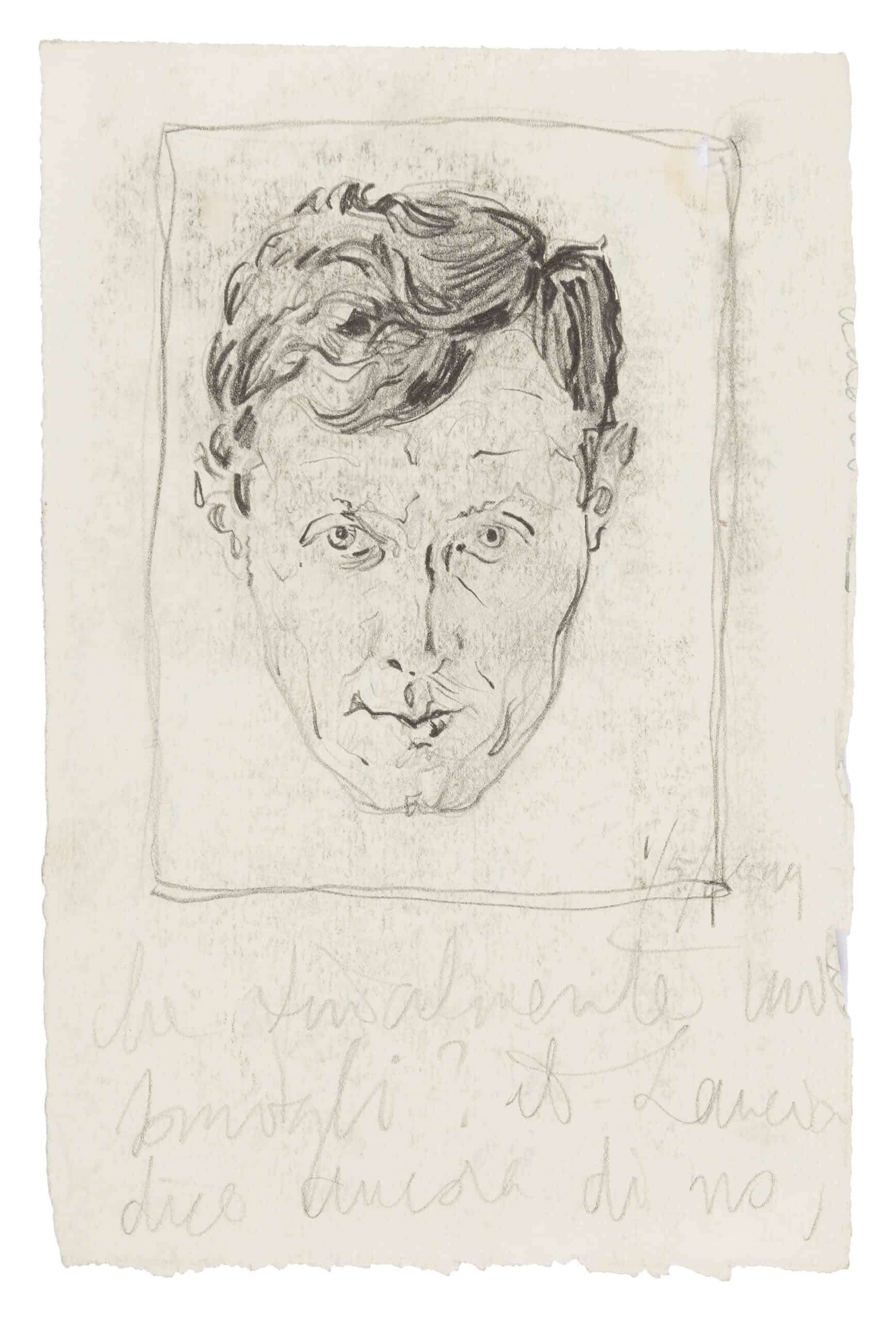
Additions and amendments are welcomed at editors@drawingmatter.org
